A recent conversation with Yang Qi about his new installation has touched me profoundly.
The installation titled ‘Church in Assisi, 2021’ is full of artistic energy and mysticism. The material is stone-heavy “stones” cast from expensive, pure paper pulp. It Intentionally expresses a historical and chronological sensation. It wins with a casual, simple form of beauty.Sentimental, melancholic, Christian and pure! Somehow poetic in an ancient architecture from Zen.

The installation has a long history behind its creation. Yang Qi has lectured at the summer art school at Koster Steinfeld for the last 23 years. One day after his teaching, he found this 11-century monastery. It seems to appear from nowhere with towers, temples and architectural styles from Medieval to Renaissance. Since then, the place has been engraved in his soul; its spirit somehow coincides with his artistic mind.


Three years ago, Yang Qi read a book about Medieval Art in Europe and discovered the story of San Francesco d’Assisi. He was deeply touched by the Saint’s kindness, determination and self-realisation. Immediately after completing the book Yang Qi made a painting.

A few months ago, they were lockdown at home in Dusseldorf; his wife Birgit brought some DVD from the library to watch; it happened one film was about San Francesco from Assisi. He told her ‘ This isn’t a simple coincidence; it is the message from God; he is telling me to be compassionate and be a good being.’ So ‘Church in Assisi’ installation was born.
In the installation, each ‘brick’ has the colour of the original pulp. It is the raw material of papermaking from a large German paper mill. It has a gigantic machine that presses paper pulp into big “stones”. Yang Qi has to break each ‘stone’ into unequal pieces, but it’s still so heavy to move into a perfect position. Labouring and long hours into consideration is the press of his work.
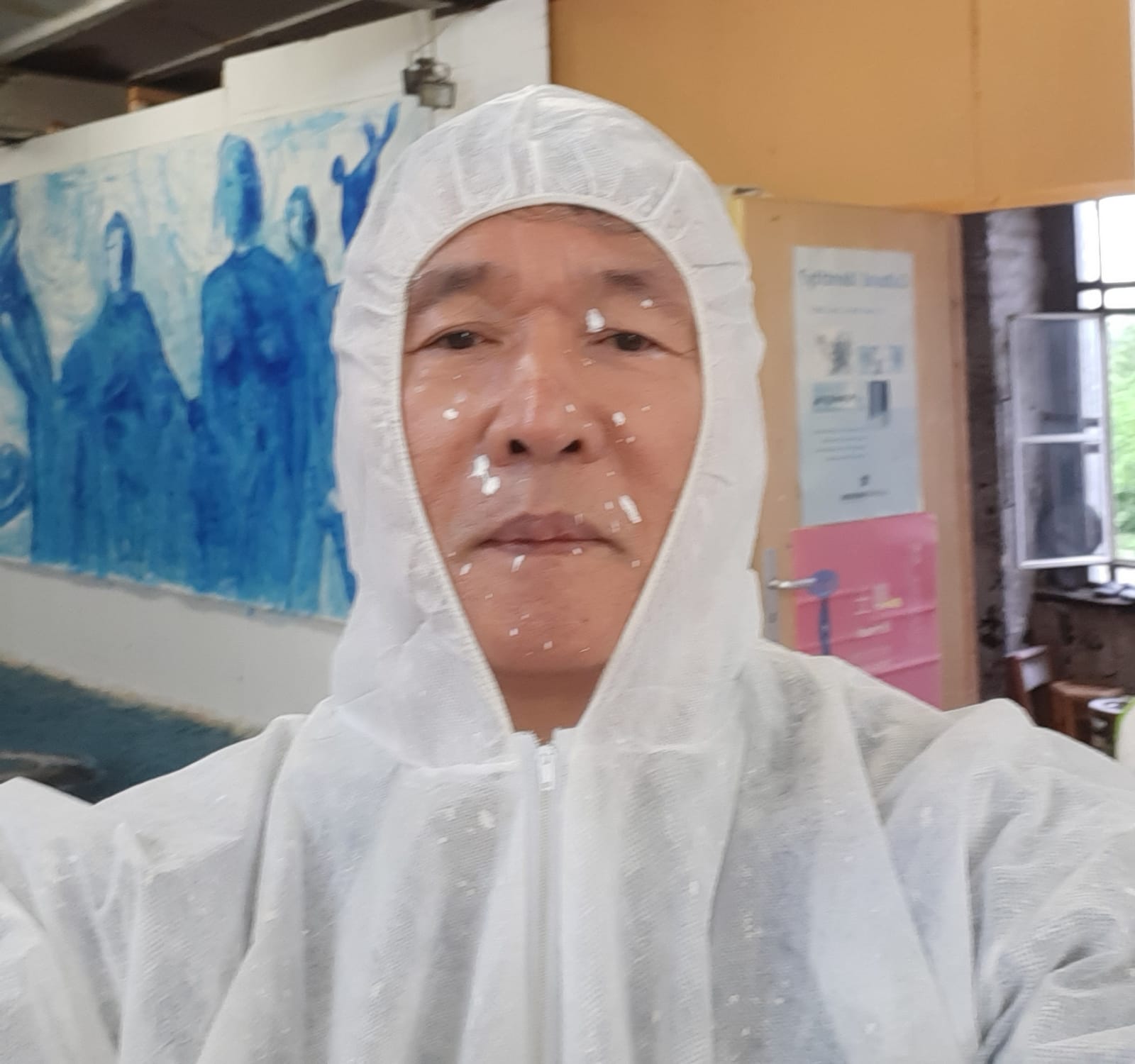
 I felt Iprivileged to share the artist’s spiritual journey of their creation.’Church in Assisi’ is the temple of his art. He offers his devotion, his compassion, enduring on his artistic journey. He shared his answer, ‘What is an artist?’ with the world.
I felt Iprivileged to share the artist’s spiritual journey of their creation.’Church in Assisi’ is the temple of his art. He offers his devotion, his compassion, enduring on his artistic journey. He shared his answer, ‘What is an artist?’ with the world.
Tang Chenghua’s creation during the period of epidemic prevention and control
Words by Wang Boxun Postdoctoral Fellow, Qinghua University Associate Professor
The sudden outbreak of Covid-19 interrupted our daily routine.
In the highly developed modern era, the new coronavirus blindsided us. We reluctantly and resolutely enter a state of stress that we’ve never experienced. Fortunately, we are now ushering in the dawn of the post-epidemic period.
As an integral part of the human labour system, artistic practice faithfully reflects social life. Nearly 150 small oil pastels, completed by Tang Chenghua during the year, reflect upon the reality of life.

Tang Chenghua was working in his studio for ‘The Colours of Life’ series in Spring 2021.

‘The Colours of Life’ series created by pastel and acrylic on paper, all the work are size 42cm x42cm, 2021.
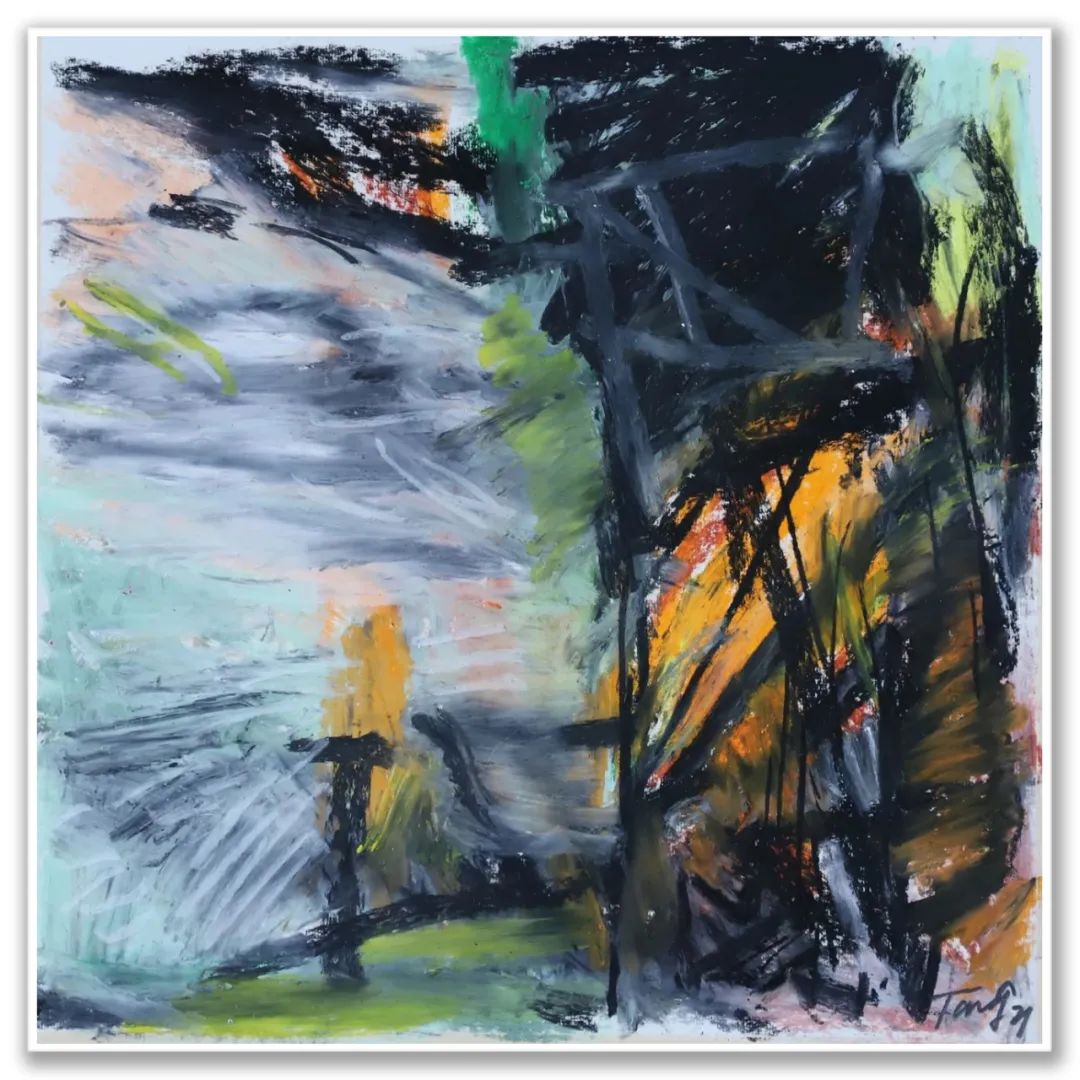
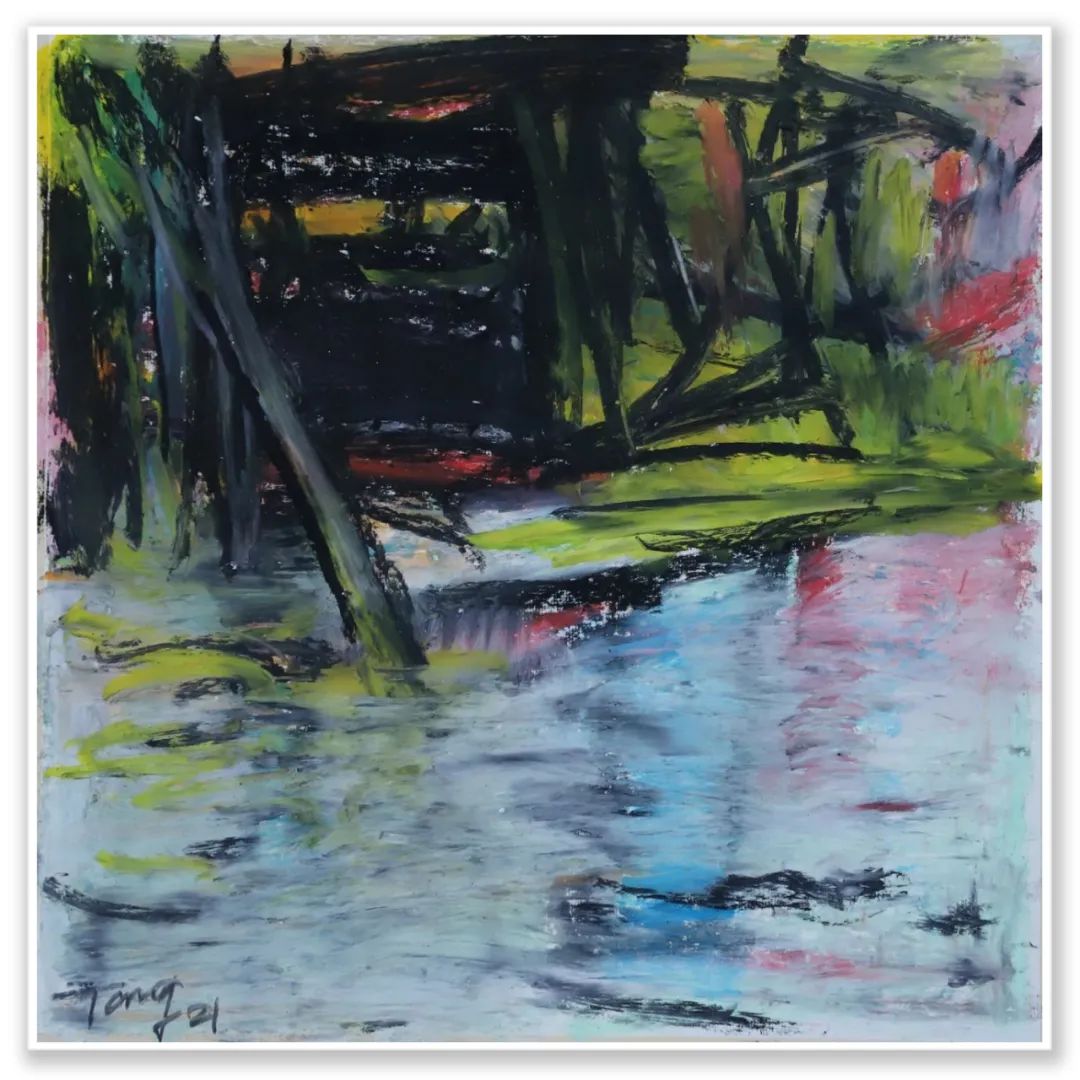
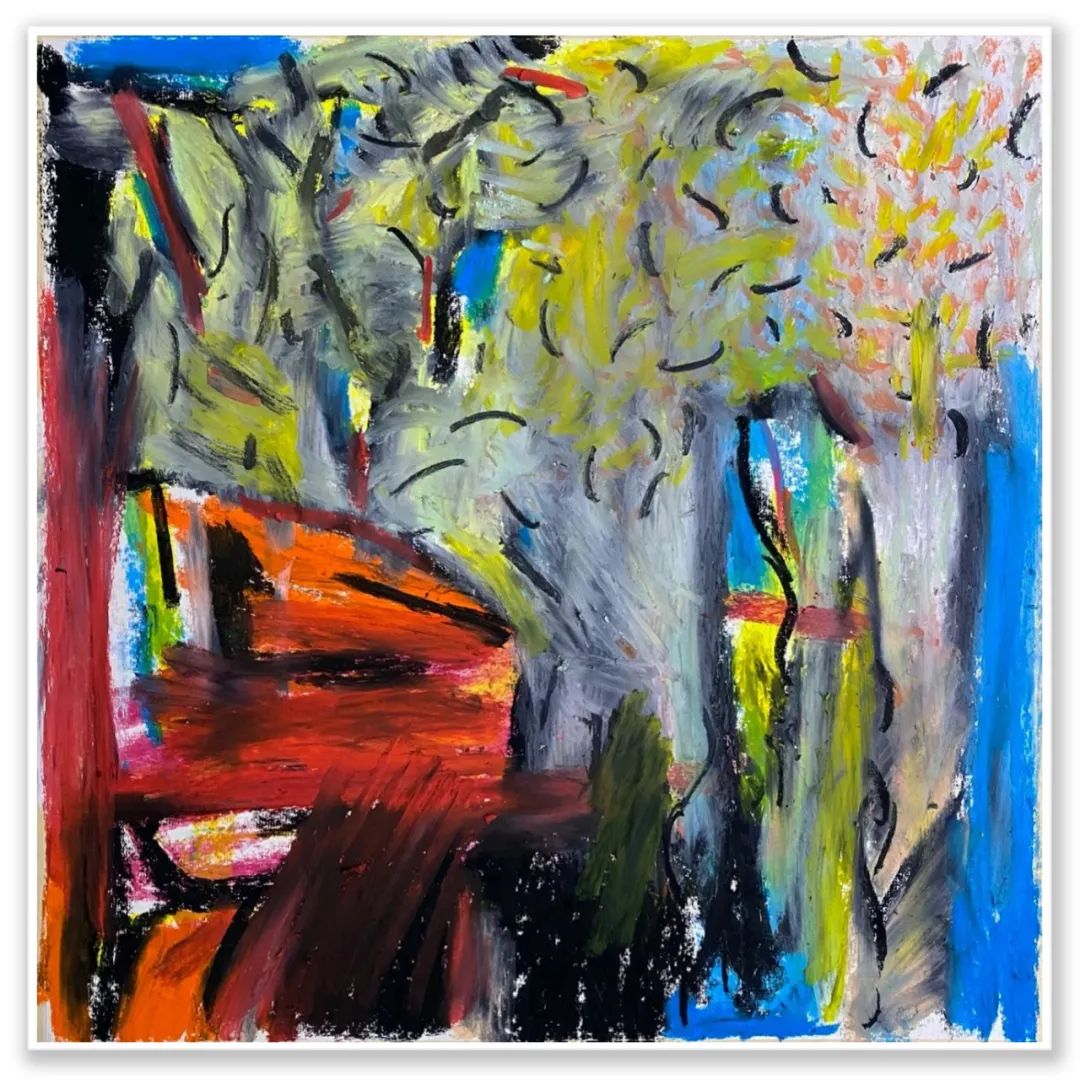
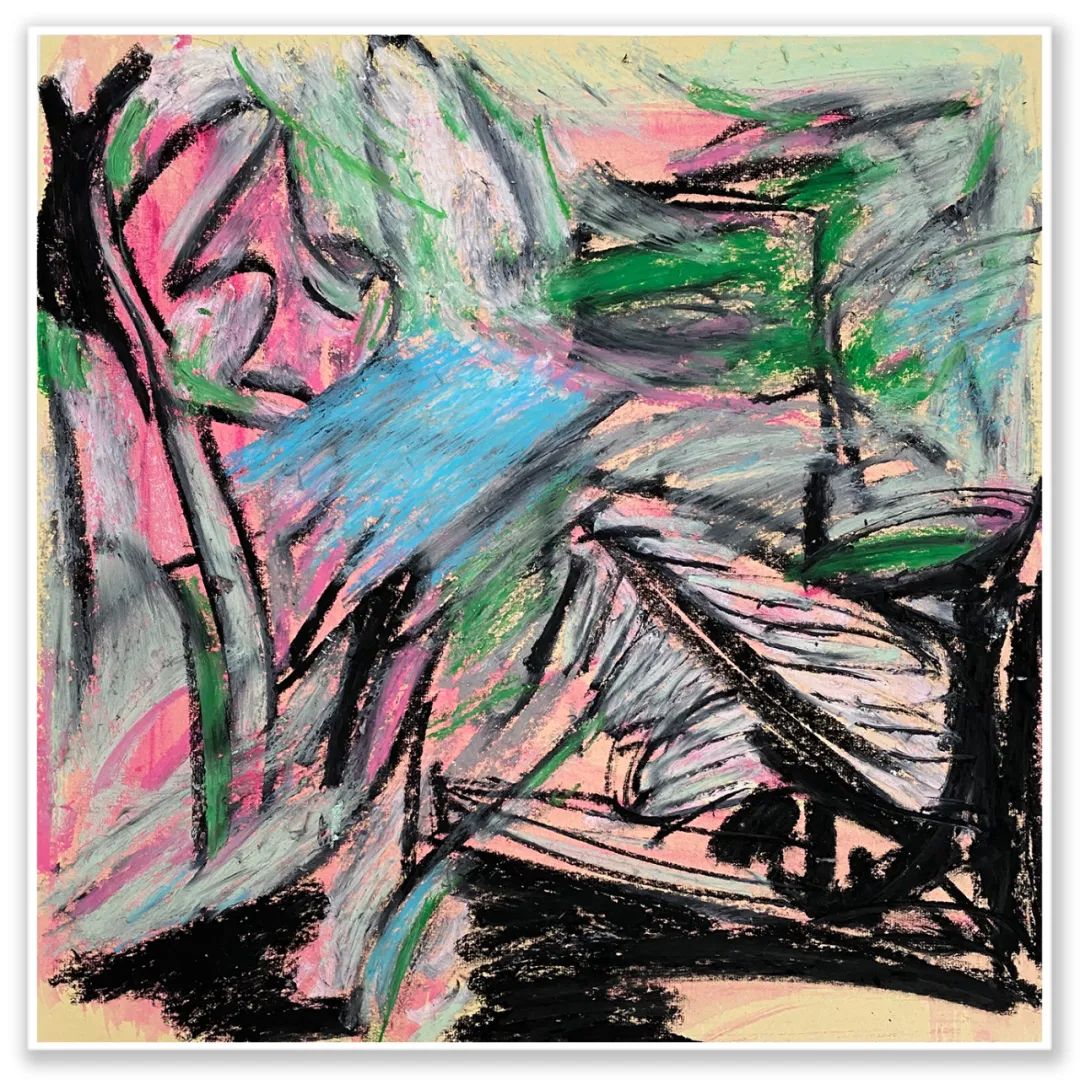


The solicitude of life is the ultimate internal cause for the occurrence of these works. Although being alone is the daily life of an artist, being alone under the epidemic differs from the past. The time that was once flowery has become dim and messy under the impact of the epidemic. For some time, the virus threatened human freedom with invisible tentacles. Essential human needs such as love, affection, trust, and helping others, have become more precious. The question of what is an artist as the origin of artistic practice has naturally emerged.

Tang Chenghua was doing life drawing in the suburb of Beijing in Spring 2021.
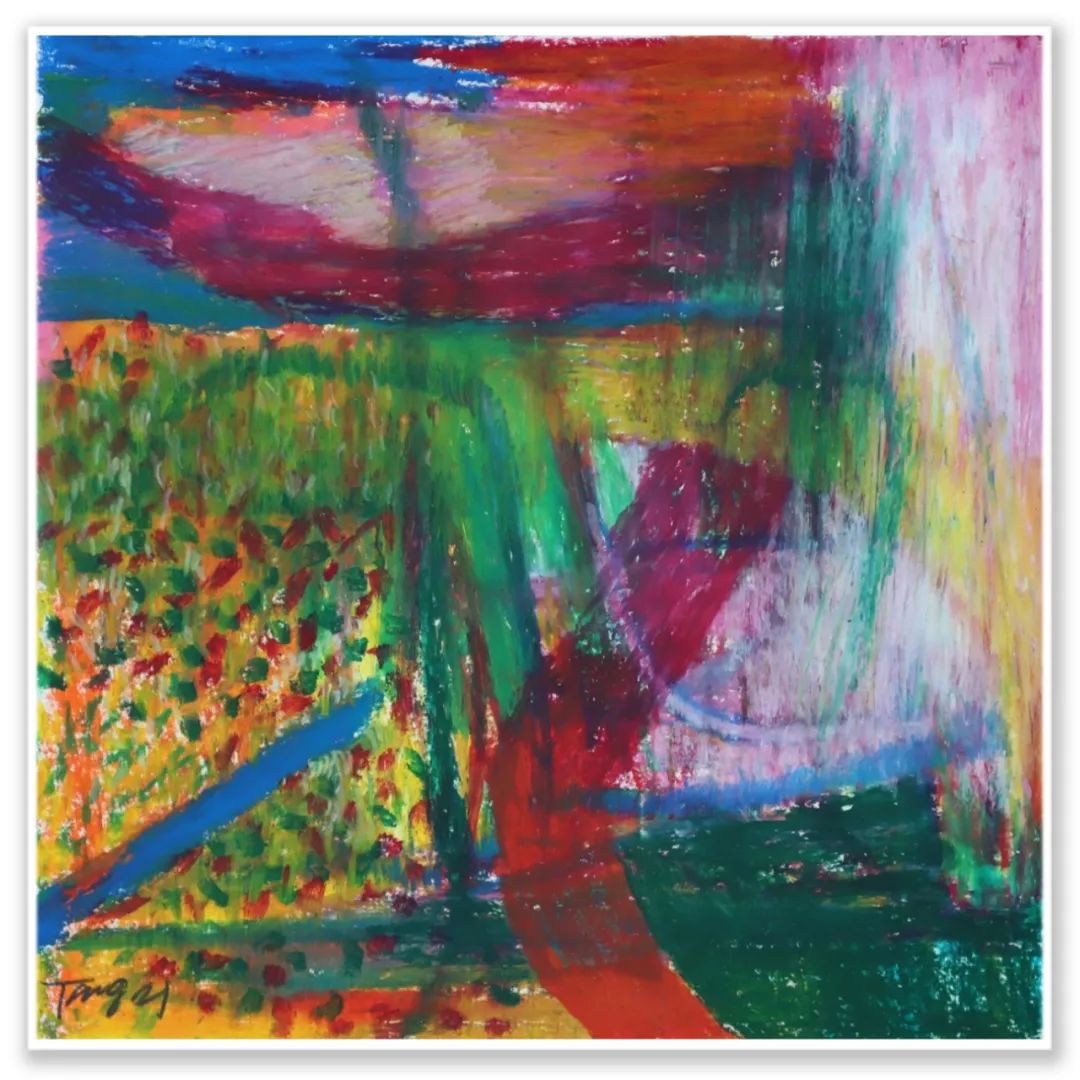
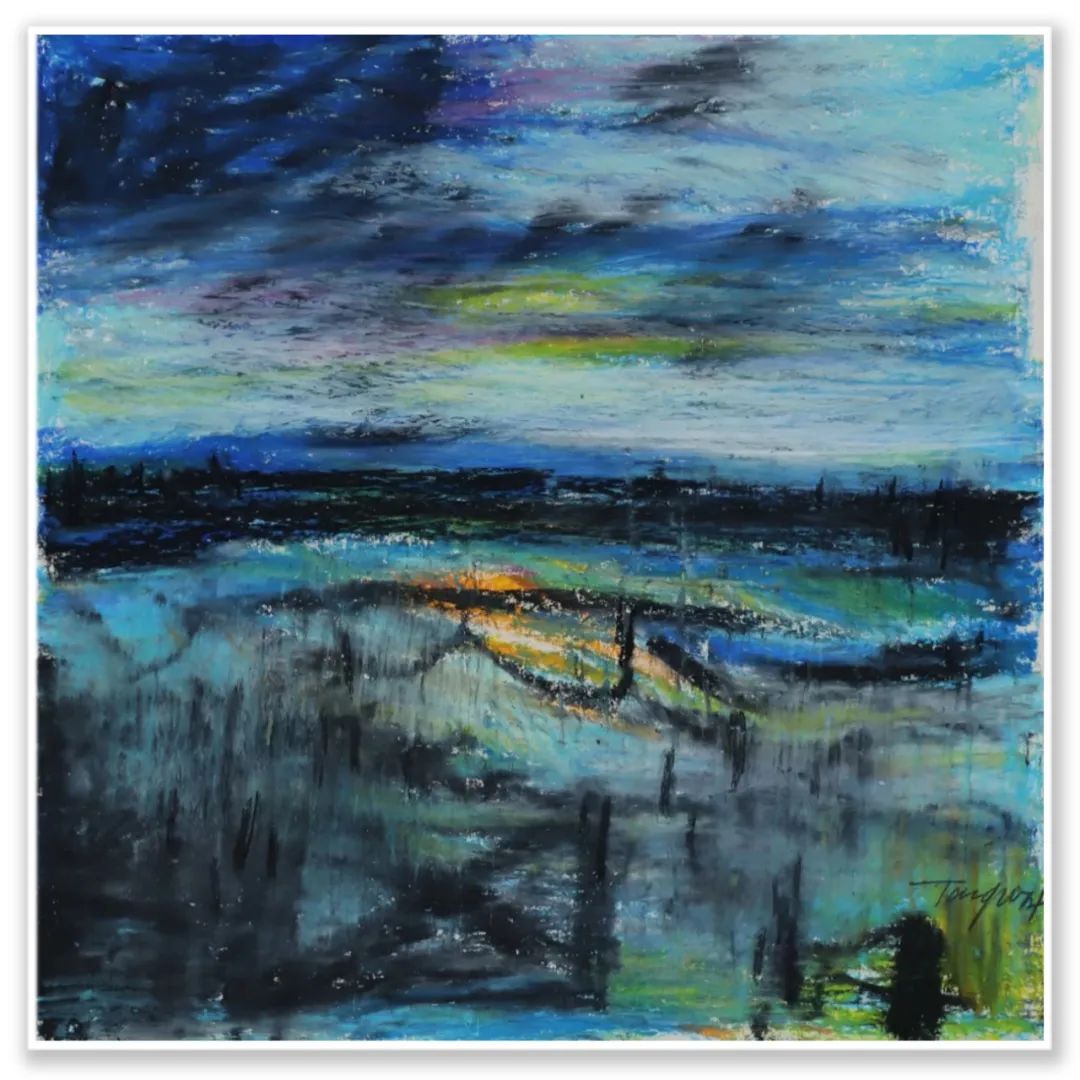
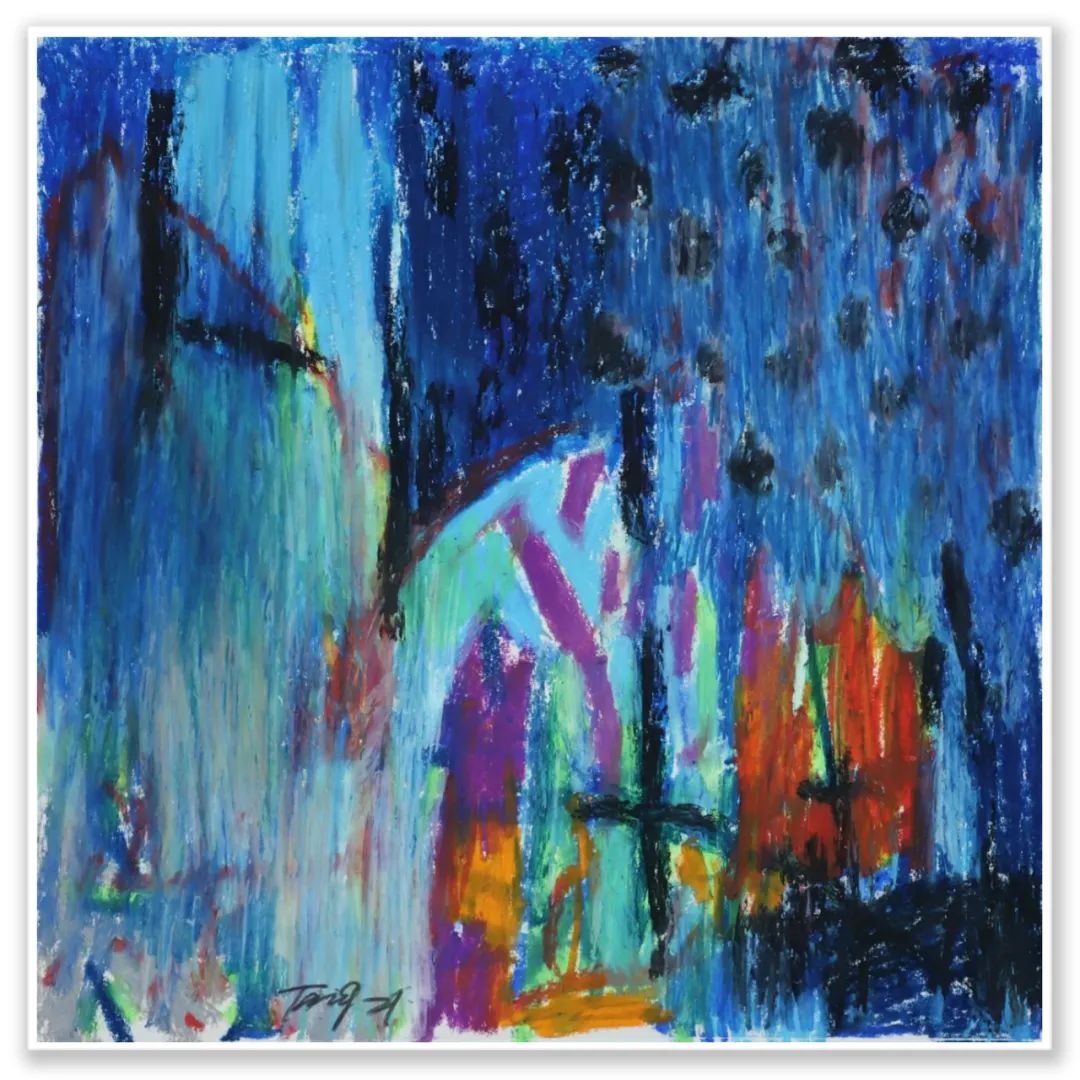
Tang Chenghua lives in his studio in the suburbs of Beijing. He stacks many cardboard and oil pastels there. The artist feels inexplicable oppression, which comes from a helpless wait and sees on the impermanence of life. Of course, the life carrier described by the artist is not only the image of the characters but also the memory of the scenery he once saw.
Regarding this creative experience, he wrote in his diary: ‘To deal with emergencies and the resulting mental pressure, the artist can only create.’ Art creation embodies not only the individual. We should consider the value concept to return to the essence of nature and the ultimate meaning of life. It is this pursuit of the ultimate meaning of life that supports the artist’s continual creativity. Therefore, the small series of works we have seen have surpassed the definition of works in the general sense and should be regarded as the artist’s image handwriting for questioning the life and soul under the passion of society. The purification of formal language is another breakthrough in this series of works.

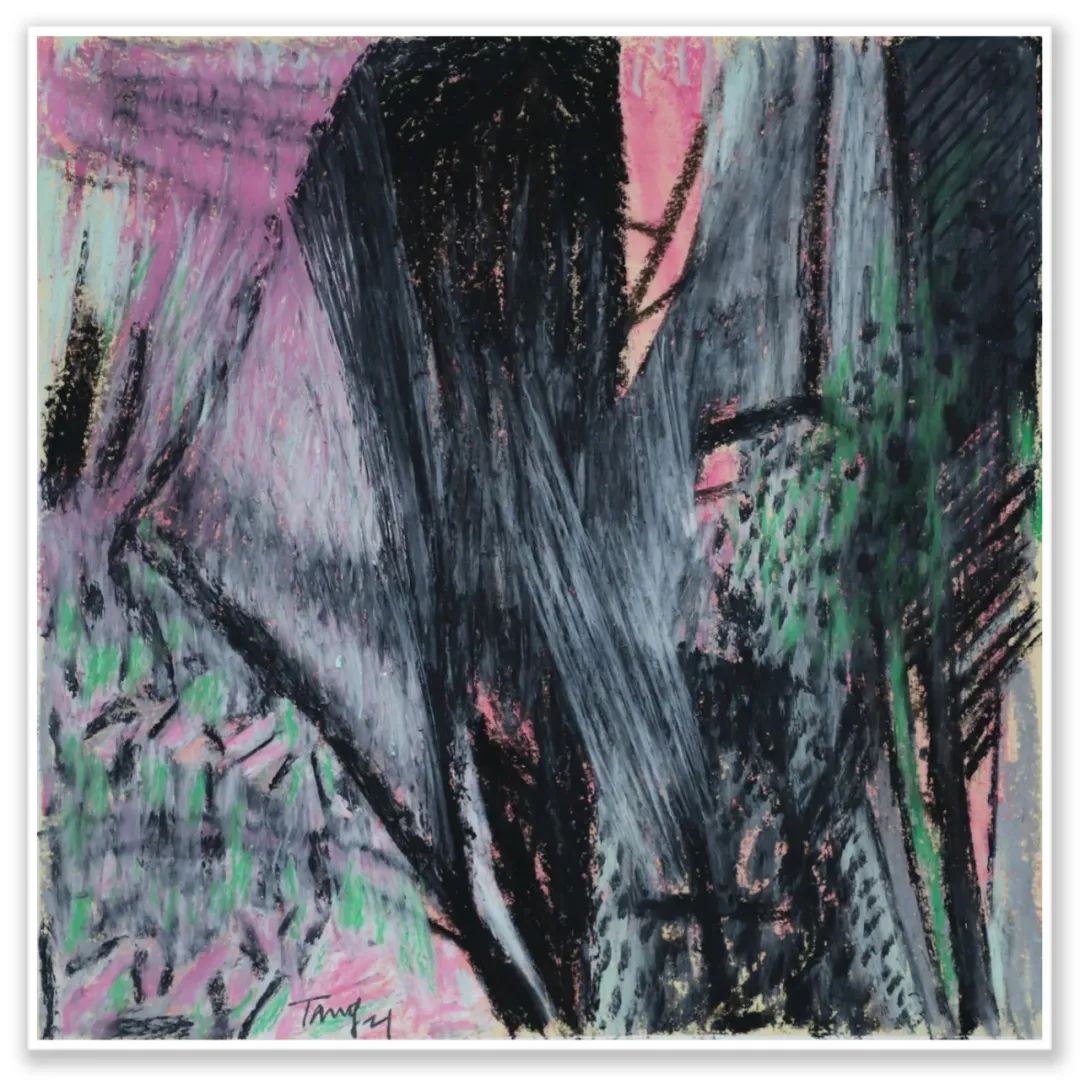

Throughout the decades of Tang Chenghua’s artistic career, cross-border integration based on synaesthetic expression has become normalised. However, pursuing a sense of painting is the central focus that he has never drifted away from. Therefore, Tang Chenghua pays more attention to the consideration of formal language than other painters. The depth of its scrutiny on the language of images is already close to the exacting requirements of scientific calculations. We can find sufficient evidence in the traces of his paintings.
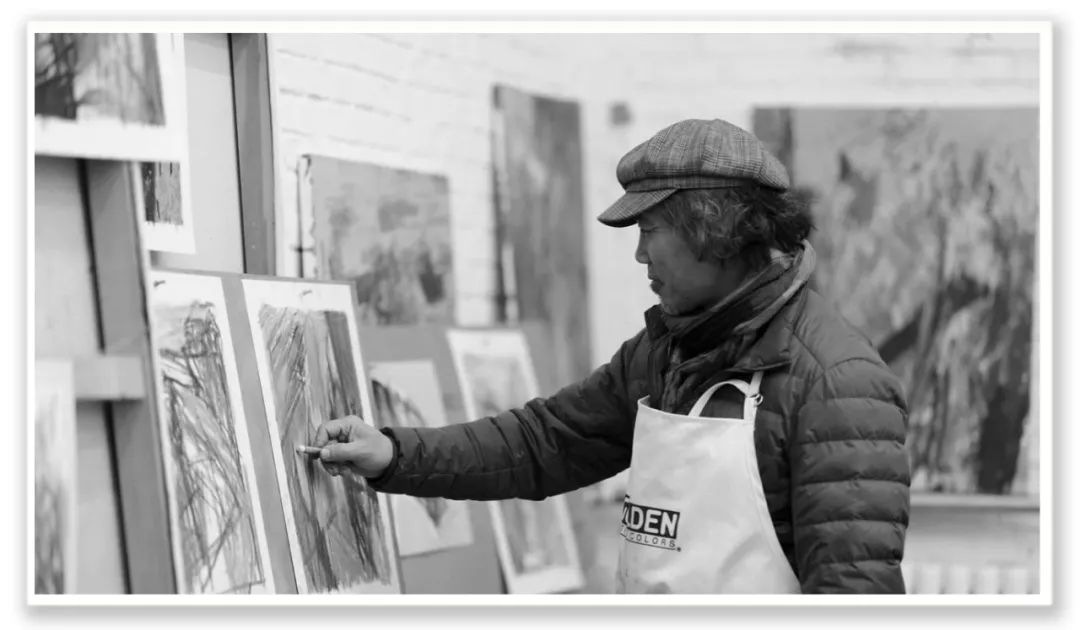
In his studio.
The cardboard used to complete this batch of works has a thick texture and a rubber sole, which has the flexibility of a canvas. This provides a technical guarantee for the artist’s repeated adjustments during the drawing process. This batch of paper works by Tang Chenghua partly continues the creative principle of ‘C Minor Long Yanqu’ ten years ago. The difference is that, based on the specific experience during the epidemic period, compared with the soft and smooth of “C Minor Proliferation”, these works are closer to the sadness and vigorous of Beethoven’s “Symphony No. 5 in C Minor”.
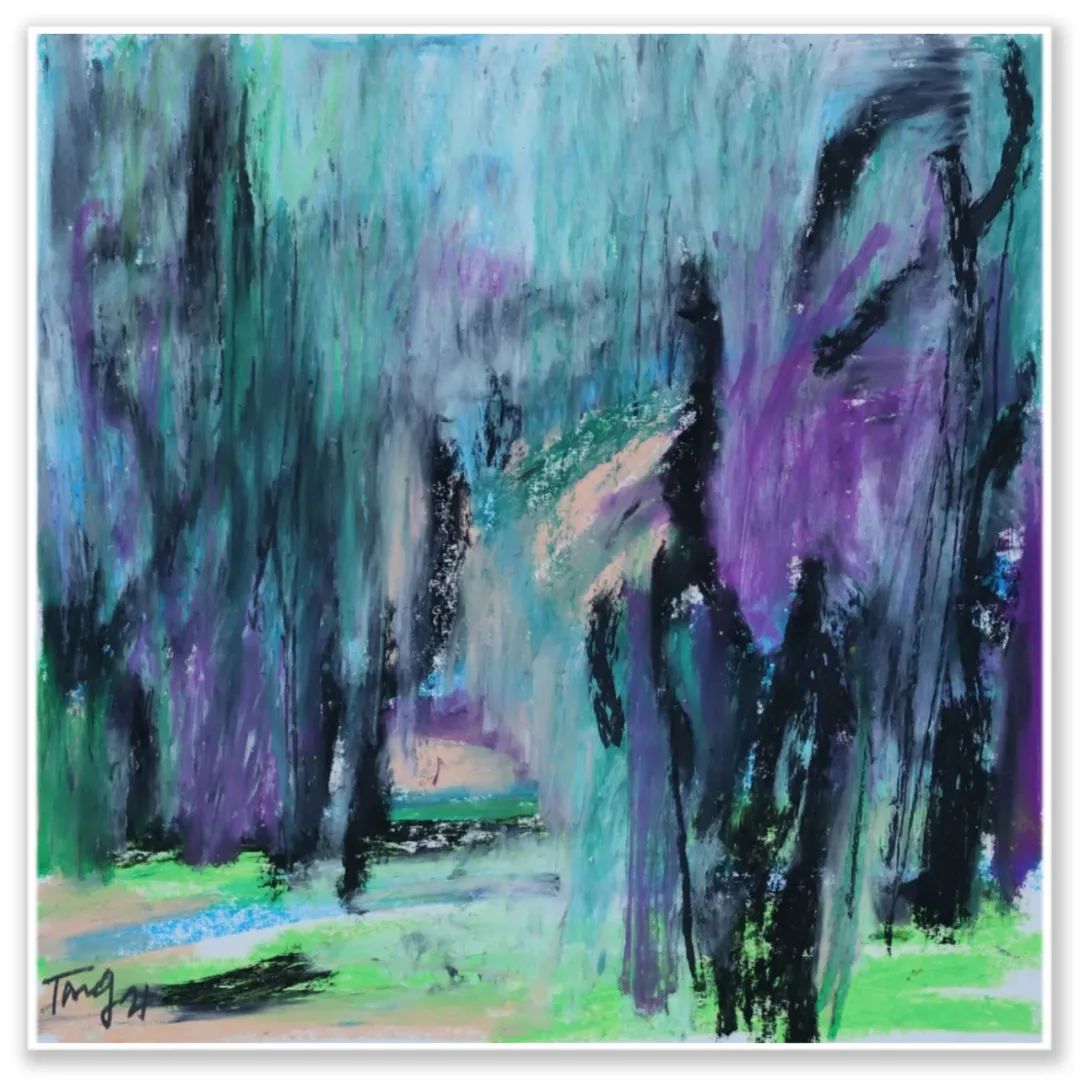
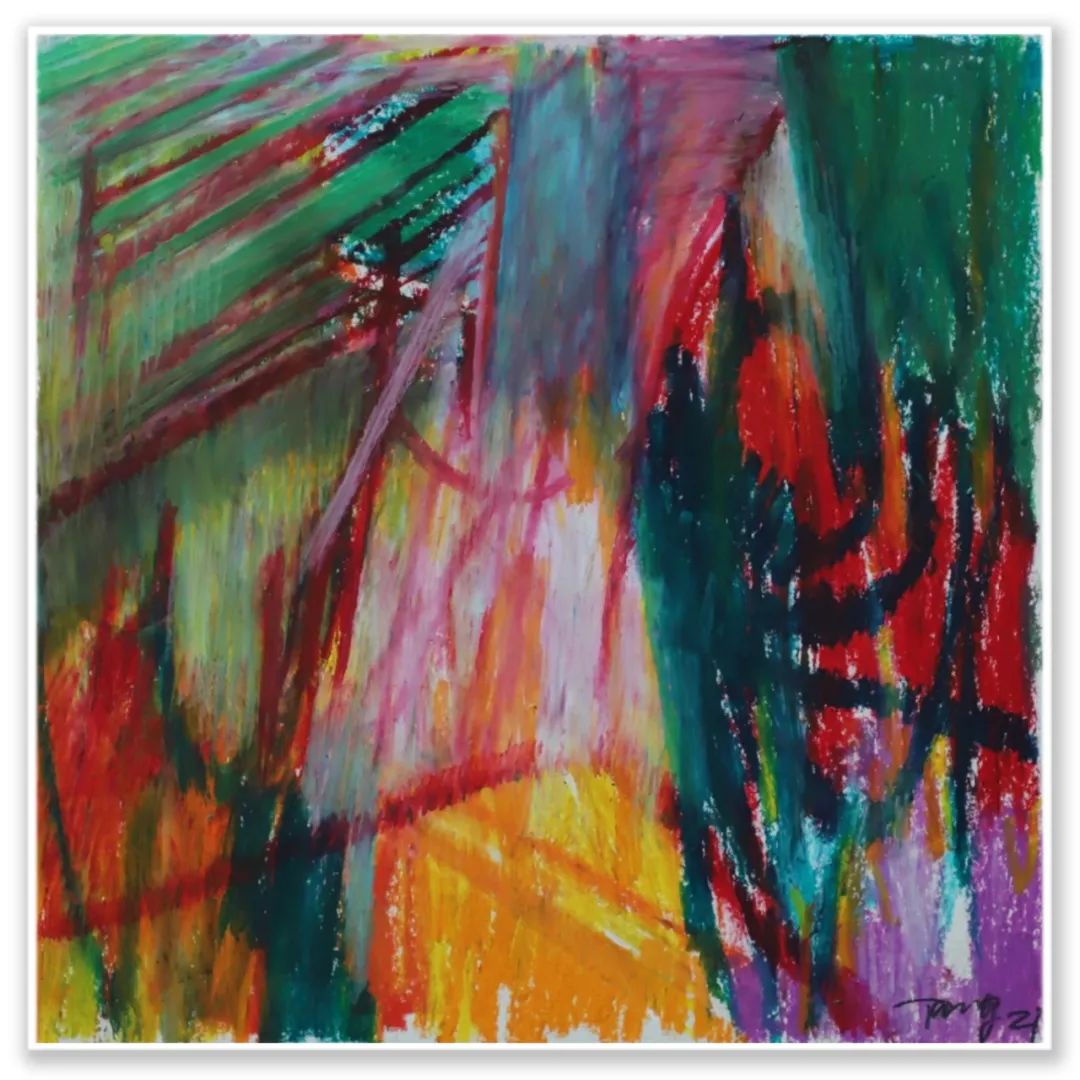
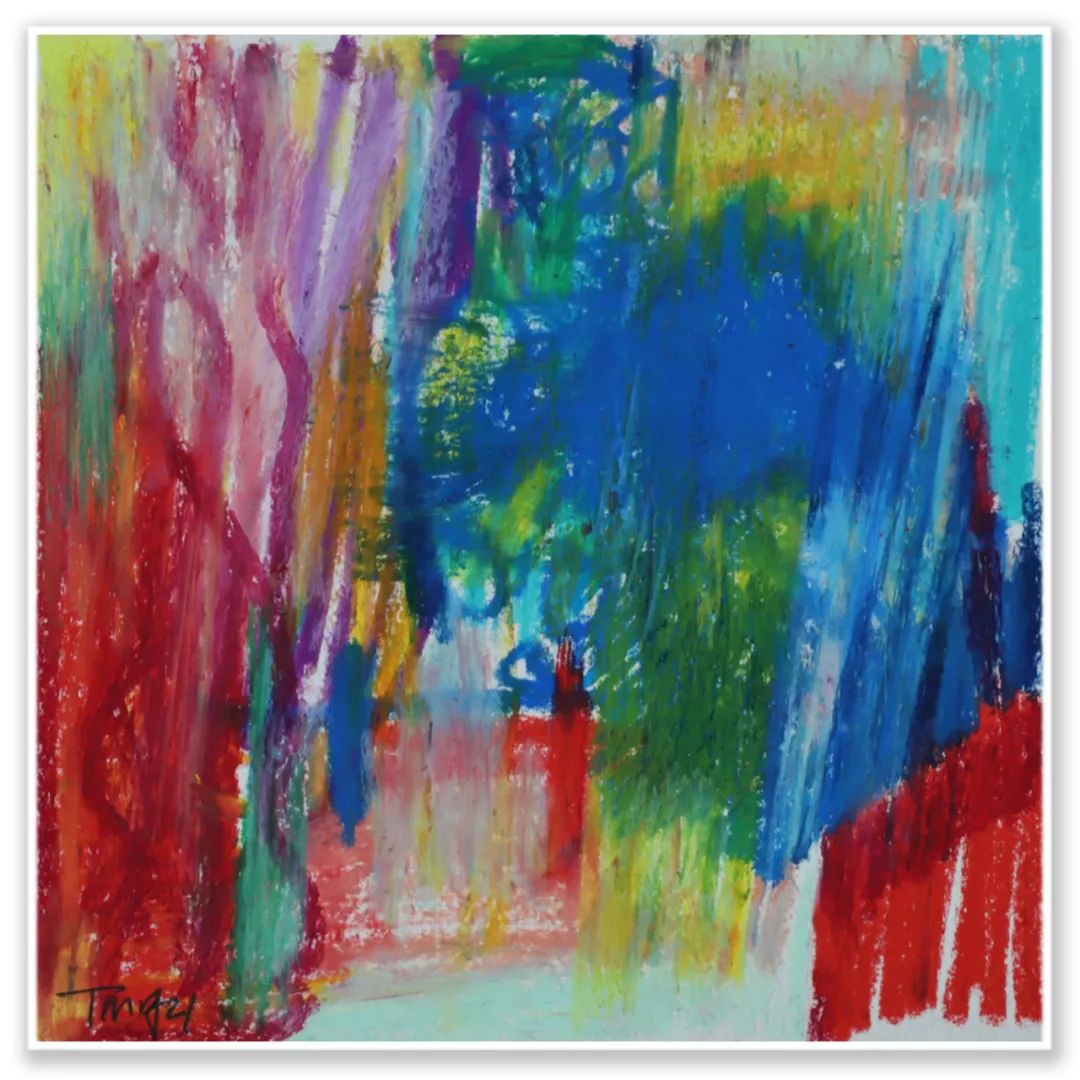
I can say that through these works completed during the outbreak of the epidemic. Tang Chenghua intelligently achieves an infinite approach to the spiritual core of traditional Chinese culture by using contemporary media.
His studio is by the Chaobai River in the suburbs of Beijing and the winter in the north is cold and quiet. Because of the size of the space, it can’t help but feel cold even if fully heated. Perhaps the moderate cold is more conducive to his penance. I once visited the studio whilst the epidemic receded and saw him working under a thick cotton coat. The scene is like a monk wrapped in an old garment practising his daily prayer, but also like a spring silkworm spinning, the sight is moving. The artist devotes himself to the piety that is close to religious behaviour in his works, which is accurately and completely restored in the interpretation process between the work and the reader.

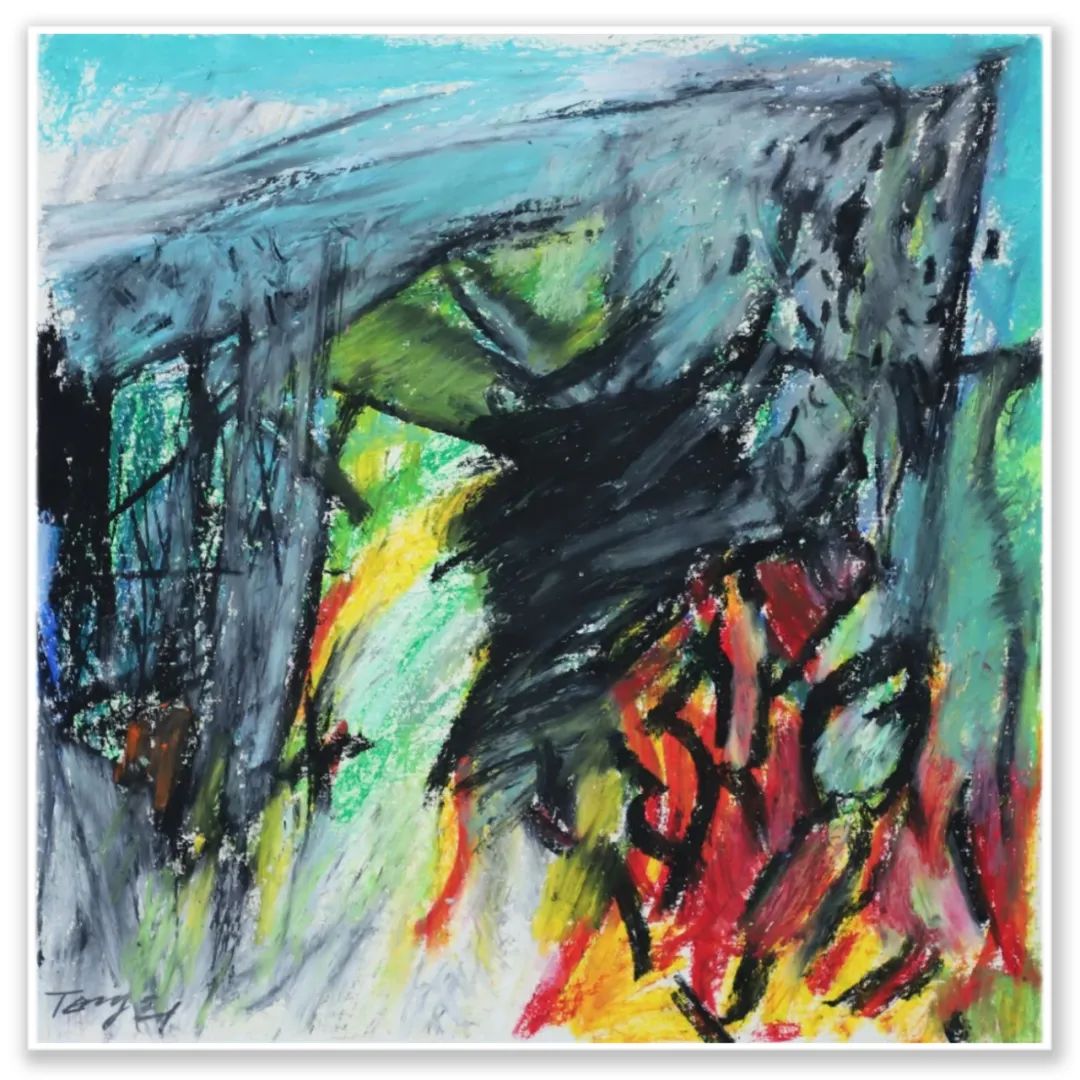
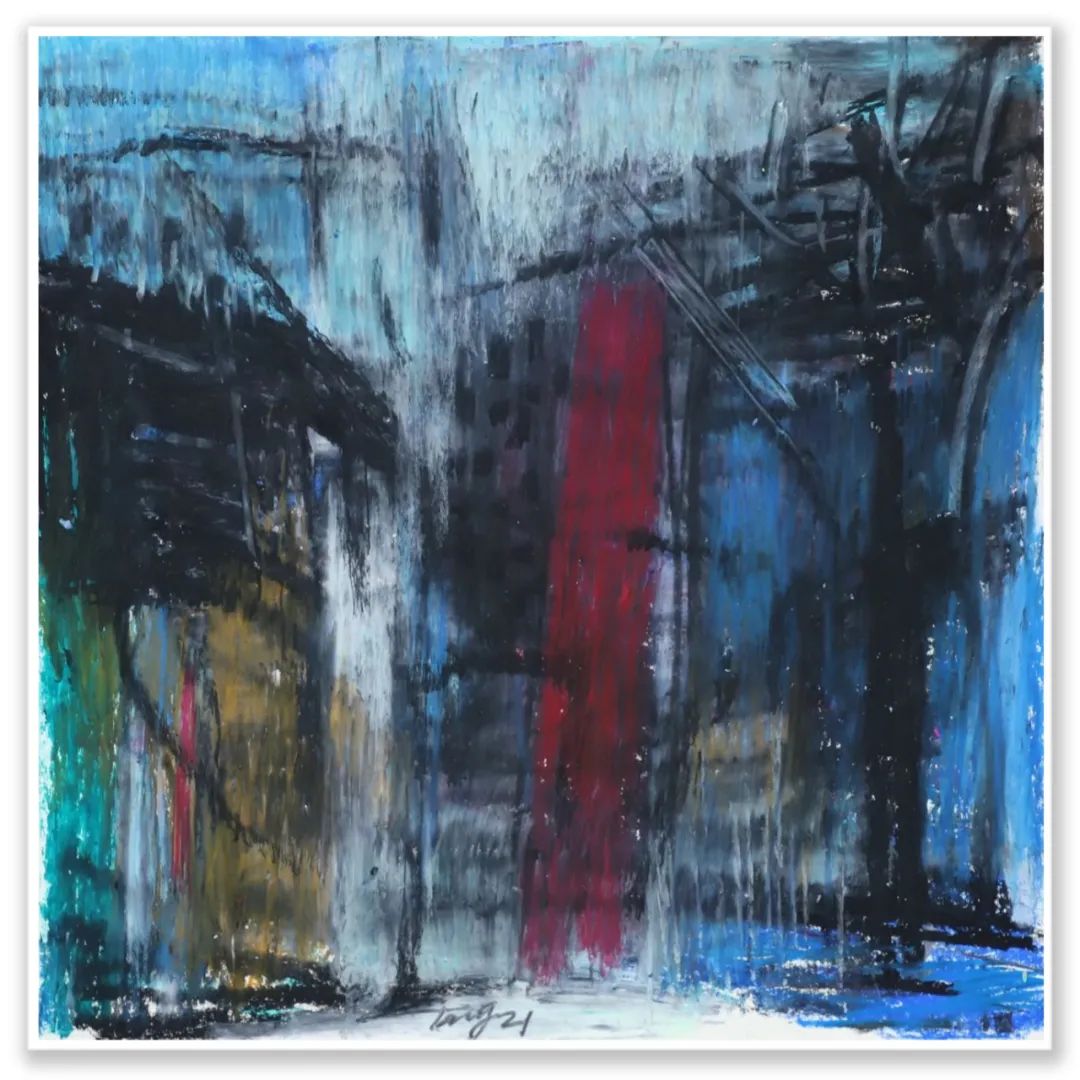
The post-epidemic era is approaching, and the social body is completing its mechanism by iterate attacking passively. Therefore, we have every reason to look forward to a bright future. This is the spiritual inspiration gained whilst interpreting Tang Chenghua’s recent works!

Click the picture to see the video of Tang’s creation of this series.
In January of 2020, I just finished an exhibition in Beijing, as the Spring Festival approached, I went back to my parents home, after a few days, Covid-19 began to spread. My parent and I did not panic a lot, every day we paid attention to the news, did our best to wear masks, reduced the purchase of daily needs, and carried on our everyday life in the lockdown step by step. Since then, I spent four months in the lockdown with my parents and two cats. It is the most extended period since I left home at 16. We sit around a different table every day, moving from desk to dining-table, making me feel like every day is a cycle of Deja Vu.


The biggest problem for me was that I couldn’t get into the print studio for the first few months; this sudden change disrupted my printing plans. This situation also has dramatically changed how I paint; I began to use the iPad to record these unusual days. I try to use a way to document my daily emotions by using drawing for my diary.

Each day, I will add one arm to record my day’s feelings (the arms and hands’ position represent the day’s mood). I wonder what diary of emotions I will have on the day when Covid-19 ends.
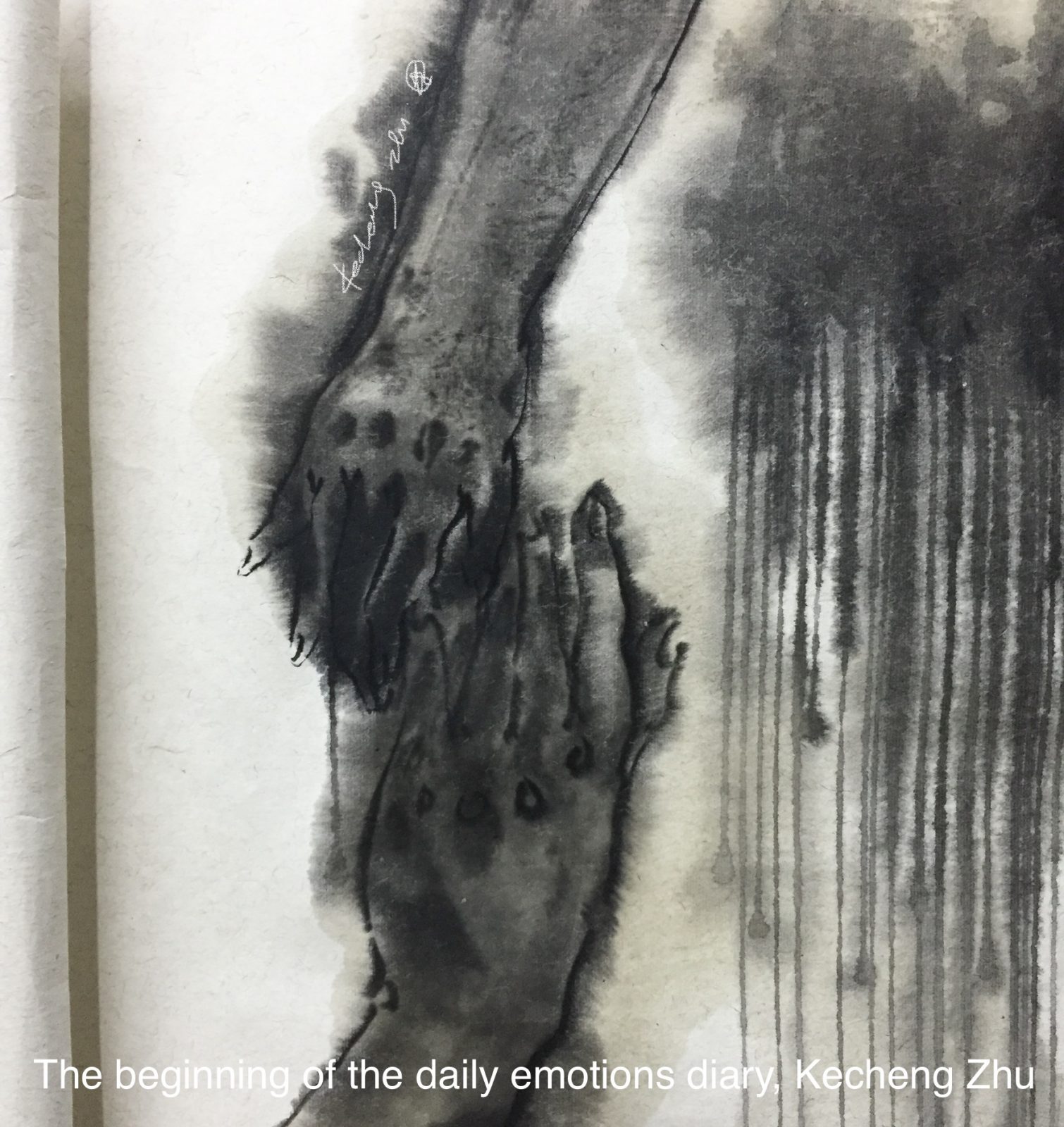
In my daily repeated record of the state simultaneously, my city also ushered in lifting the lockdown around May 2020. Due to everyone’s efforts, my city is not troubled by Covid-19, but such actions also need our persistence. It’s been a year since the start of the 2020’s epidemic and will usher in the Spring Festival of 2021. I write this paragraph, and this diary work is still going on. I believe that all these things happened during this period will potentially influence my creation.
Words by Kecheng Zhu on 01/02/2021
It is good news that Tang Chenghua is going to open his solo show, titled ‘Watching’ on 27th Sept. 2020 at Qiandu Changjiang Art Museum in Taiyuan, China. The exhibition will be open to the public until 5th Jan. 2021.
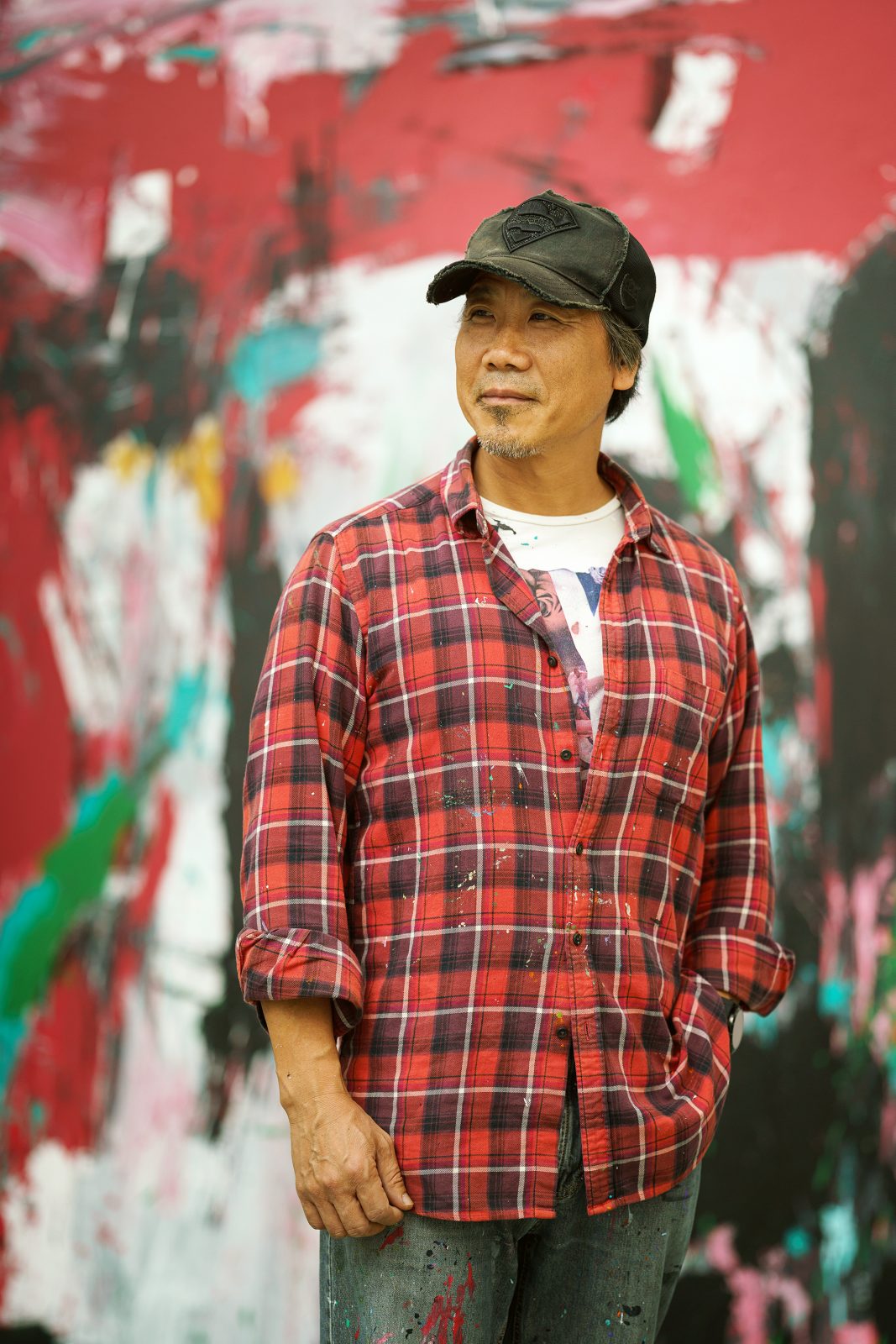
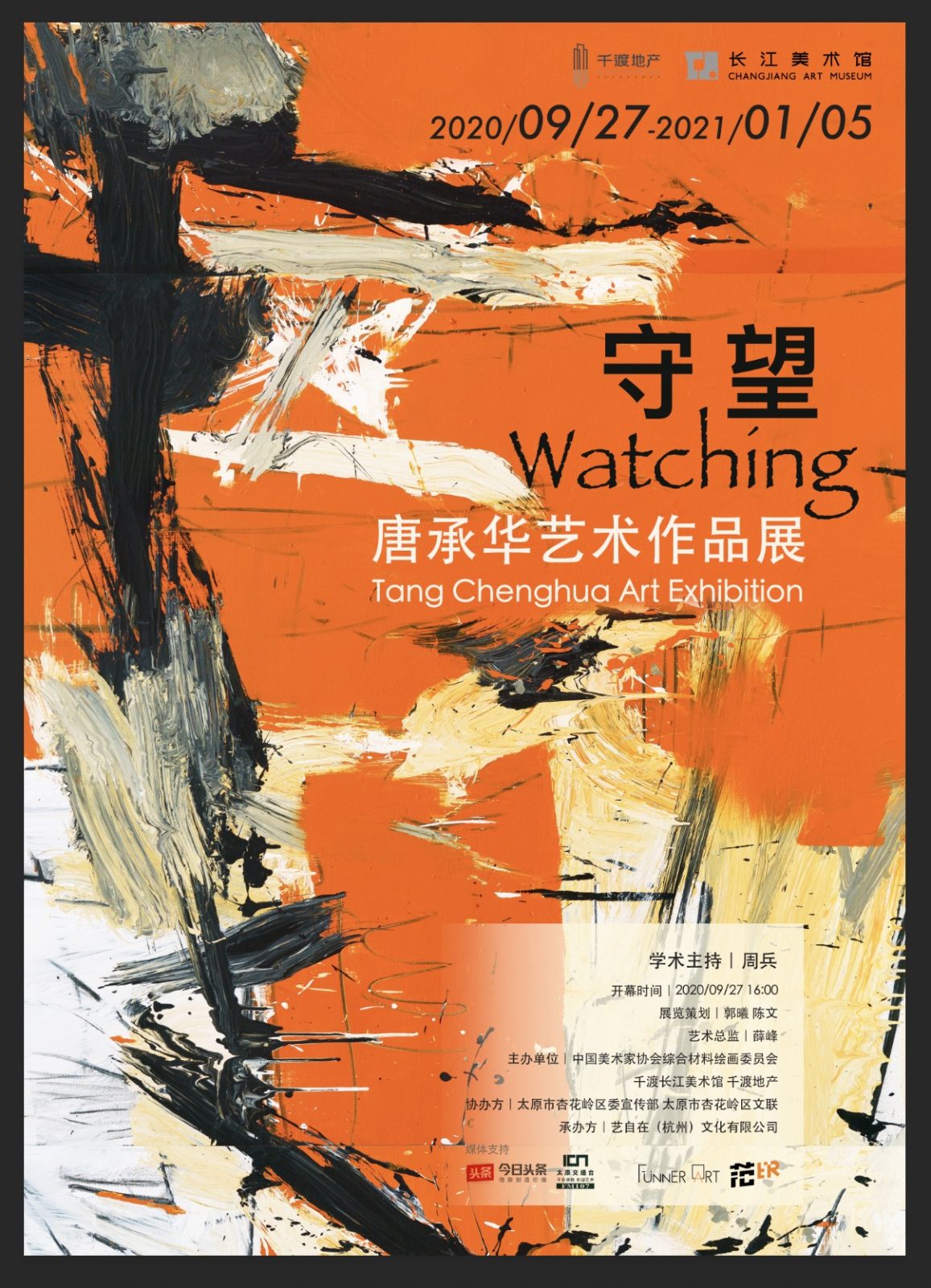
As we know how difficult it is for artists and art exhibitions this year. Tang said: “Due to the epidemic, my many schedules in this year, such as sketching, exhibitions and other activities have been forced to cancel. Recently, I haven’t done much painting but reading, exercising and resting. During quarantine, I did in-depth thinking of art and life, especially the revaluation of life.”
 ‘Blossoming Apricot Tree II’, Acrylic on Canvas, 105cm x 690cm, 2020
‘Blossoming Apricot Tree II’, Acrylic on Canvas, 105cm x 690cm, 2020
The exhibition title “Watching” is Tang’s reflection on the present situation in our world. When humans are facing the unknown virus which is causing a worldwide disaster. The kind nature of “watching and helping each other” has naturally become common sense for all humans, and the fundamental support for “Watching” must be the expectation and yearning for a happy and beautiful future.
 ‘Blossoming Apricot Tree III’, Acrylic on Canvas, 200cm x 750cm, 2020
‘Blossoming Apricot Tree III’, Acrylic on Canvas, 200cm x 750cm, 2020
The new series painting ‘Blossoming Apricot Tree’, which Tang painted recently, is also the focus piece for this exhibition. “When we see apricot flowers in early spring, we should not forget the Bible’s revelation that the apricot tree, as a tree of vigilance and watchfulness, heralds the coming of spring and the revival of all things. God is in charge of the universe, and his promises are unchangeable and never delayed” Tang said this is where he takes inspiration from for the new paintings.
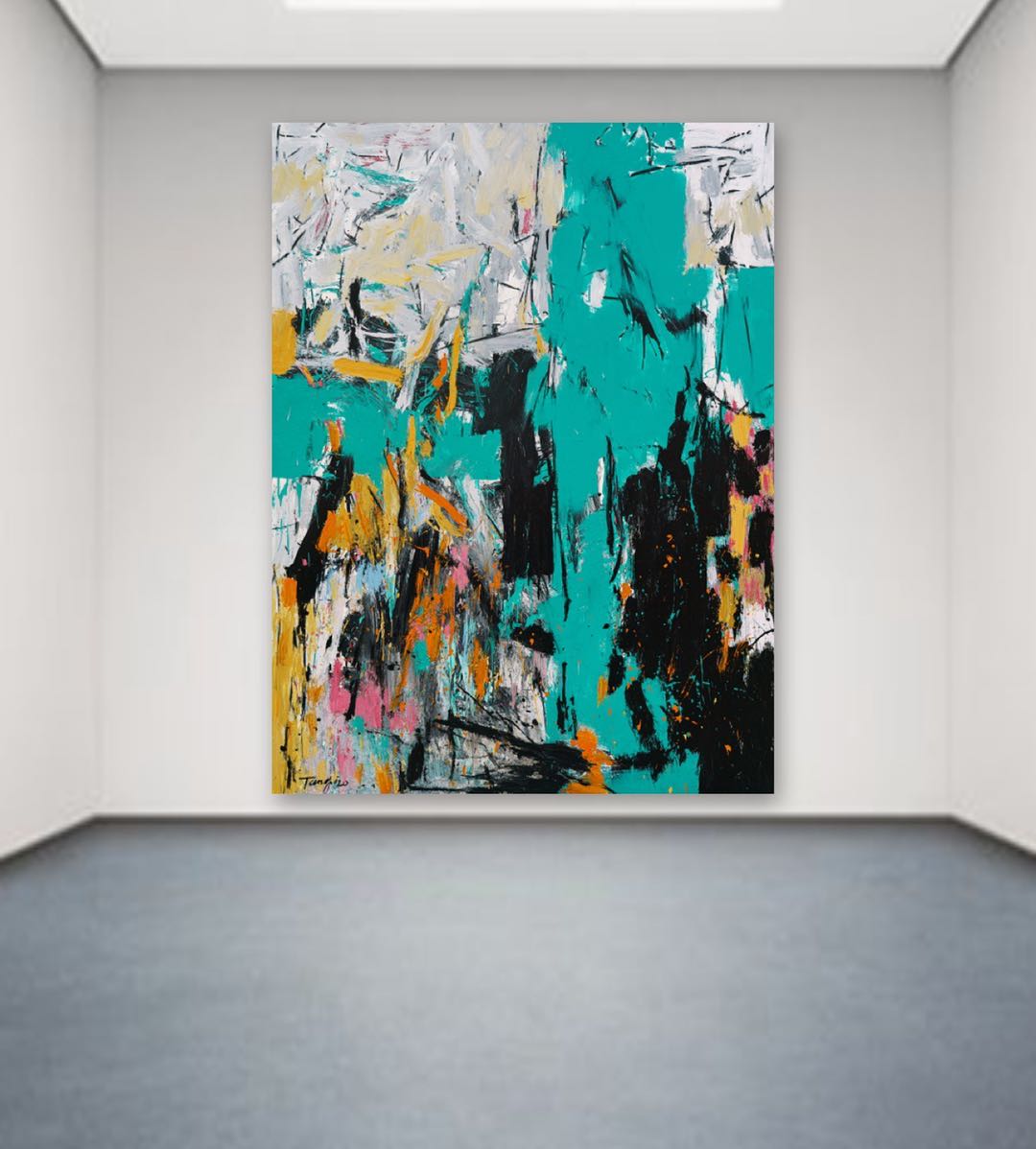 ‘Blossoming Apricot Tree IV’, Acrylic on Canvas, 320cm x 240cm, 2020
‘Blossoming Apricot Tree IV’, Acrylic on Canvas, 320cm x 240cm, 2020
‘Every collision will make you unforgettable, will let your endeavour rise again at the moment when your encouragement is about to disappear. Each time, the failures and setbacks experienced in this situation create a context of real experience that cannot be obtained by painting.’ Tang added.
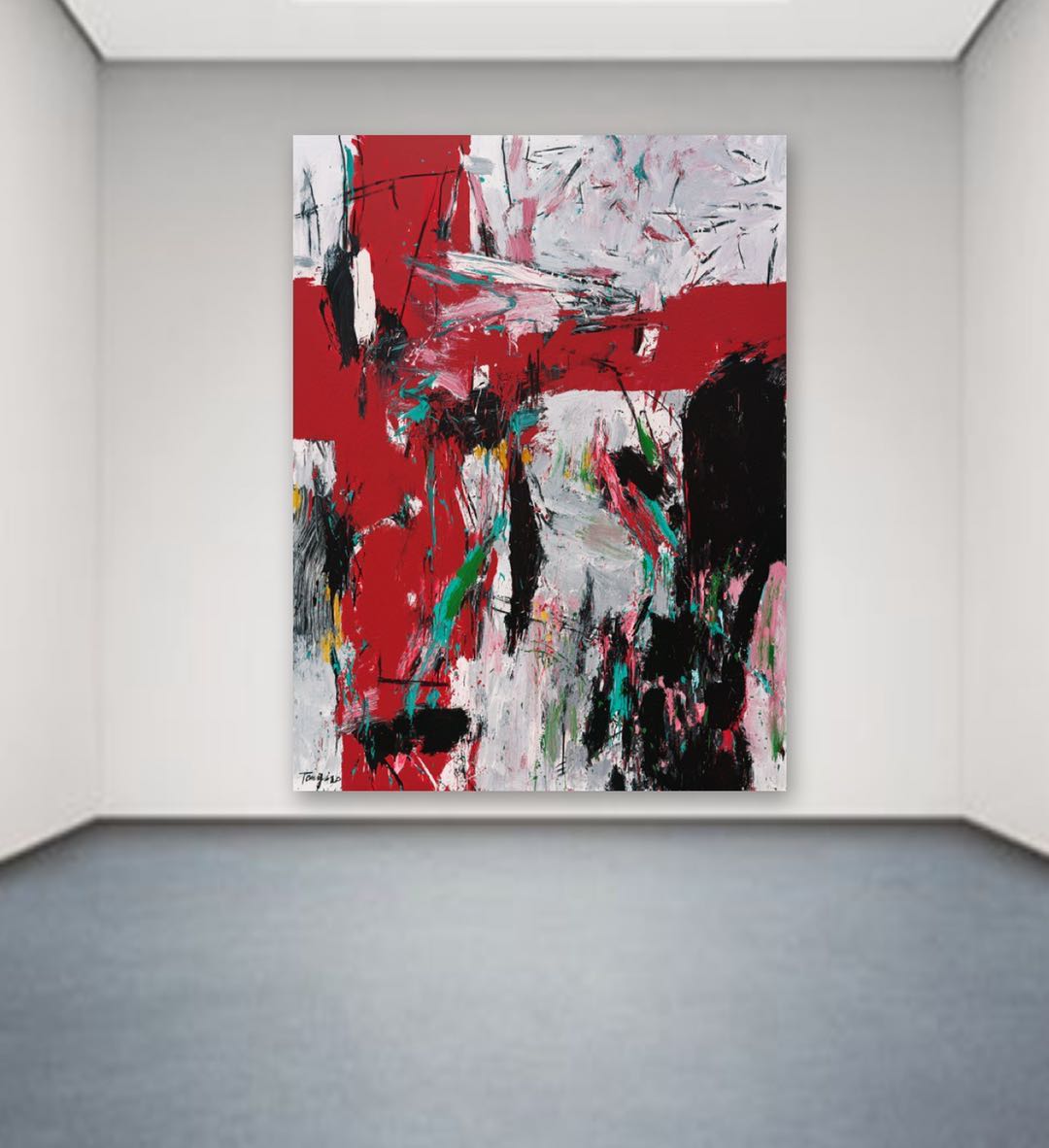 ‘Blossoming Apricot Tree V’, Acrylic on Canvas, 320cm x 240cm, 2020
‘Blossoming Apricot Tree V’, Acrylic on Canvas, 320cm x 240cm, 2020
His painting depicts the mythical relationship between self-awareness, physical space, and daily experience. He employs the language of aesthetics for an order to sway the brush on his canvas, between space and objects, to seek the colour interaction and balance between human and reality, nature and the state of the moment.
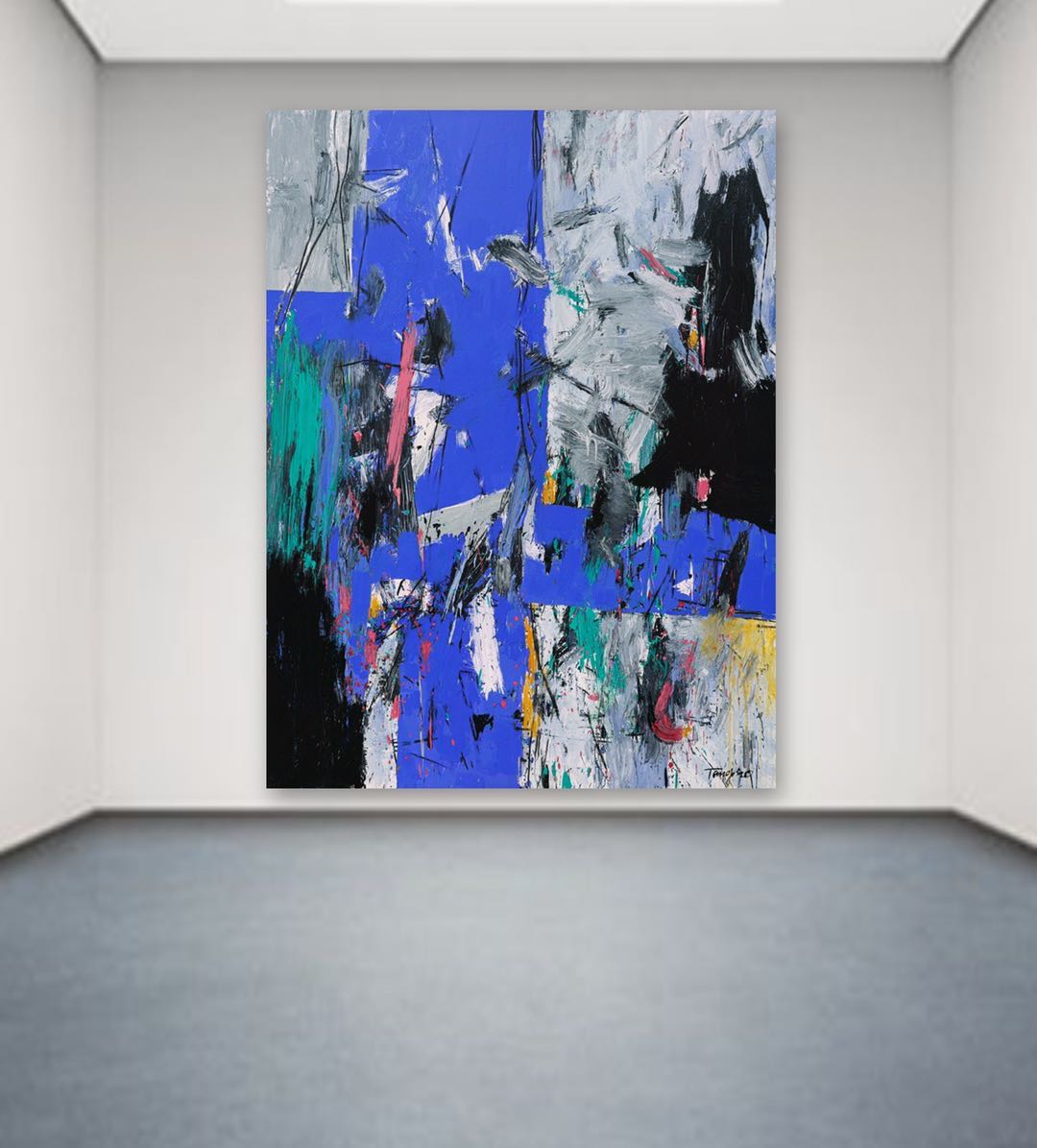 ‘Blossoming Apricot Tree VI’, Acrylic on Canvas, 320cm x 240cm, 2020
‘Blossoming Apricot Tree VI’, Acrylic on Canvas, 320cm x 240cm, 2020
It is not difficult to see that the series of new works exhibited in the show and the source of inspiration cannot be separated from the artist’s experience during the quarantine period. Through this philosophical formal language, it shows that Tang is deeply inquiring about perception, imagination, and the fundamental power of beauty.
If you are interested in Tang’s painting or for commission’s by Tang, please email aimin@artchinauk.com.
‘The collection of Puppet People’, is a collection of 57 black and white woodcuts by the young female artist Guo Shuang. These prints and the stories behind them touched me deeply. Her bold cutting lines vividly portraits each character and the words in the background that tell their stories adds, along with the sheer amount of time that has gone into creating them, weight to this provocative series of prints.
Here are Guo Shuang’s own words about ‘The collection of Puppet People’:
There is a group of unusual people who are very lovely. They all got this disease called Ankylosing Spondylitis. The disease has caused some of them to be blind, and some to be paralysed, and being disabled they have had to stay in their houses, sometimes for years. Yet, they have managed to open a window and to connect, with the outside world.
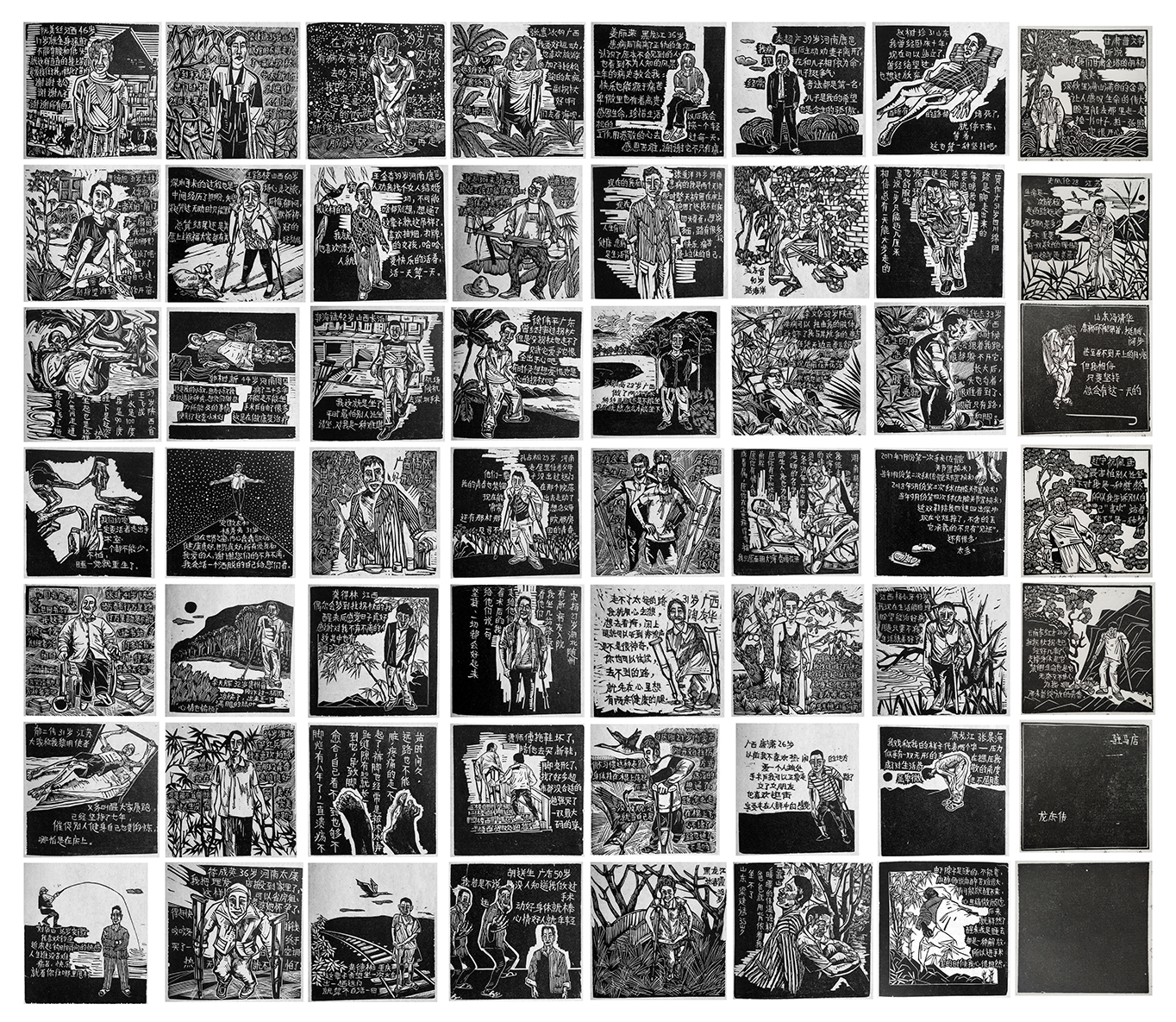 The little things in our daily life that we take for granted can often be a major endeavour for them. I can still remember all the start points of my own uncle who able to do first time in his life, such as to be able to sit up eating, to walk without walking sticks, to get on a train, go to the cinema, climb the mountain…
The little things in our daily life that we take for granted can often be a major endeavour for them. I can still remember all the start points of my own uncle who able to do first time in his life, such as to be able to sit up eating, to walk without walking sticks, to get on a train, go to the cinema, climb the mountain…
I started this series in August 2018, and I did not finish it until 2020. Each person suffering from the disease has a moving story to tell.
Take Tao Youhua from Guangxi, for example, his legs and feet are completely stiff, his heels are aligned inward, and his left foot point to the left and the right foot point to the right. They are in a straight line, like fishtails. He walked with crutches to prop up his legs. From a distance, his body looked like a piece of clothing hung on a hanger and floating above the ground. He said that if he ever stars in a horror movie, he doesn’t need any special effects.

Another example is 40-year-old Li Hua, whose arms can be lowered, but not raised. He can’t hold chopsticks for eating properly and can’t move them to his mouth. So, he instead uses “T” crutches with a fork. Tie a spoon at one end, hold the lower end of the crutch in your hand, turn it, one spoon for rice and one fork for other food. Three meals a day, every day is the same.

Zhang Jian from ShanXi said: “We have always been told to read as much as you can, travel as far as you can go. I cannot walk in my lifetime, so I built a small library called ‘Loving to Read’ for the elders in my village”.

Liu Qinggang from Inner Mongolia told me that: “Initially, I was very uncomfortable with this way of walking. I hung my body on the stick and dangled. Later, I figured out that there is no rule on how to walk. I just imagined that I was flying on the stick. Got my head around the thought, and the road unblocked…”

Yu Erwei is blind and his whole body is suffering from Ankylosing. He uses a special mobile phone to do morning calls to the morning runners in order to encourage them kept going without failing for the last eight years. He does his exercise on his bed afterwards every day. If you woke up by this morning call, how would you feel? Everyone called him the ‘Messenger of Dawn’.
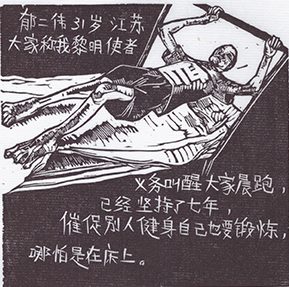
There are so many people and stories, and each one touches me very much, each of them has such a vivid soul. They all defeated everyday problems themselves, went out of the door to open the window to their souls and helped others as much as they could. I admire them very much.
Conversation with Yang Qi is always inspiring and fills you with joyful laughter. He got this great sense of humour and endless passion, qualities that also make their way into his art which poignantly depicts the spirit of the contemporary experience. His recent large painting titled “Sleepless” is a great example of this.
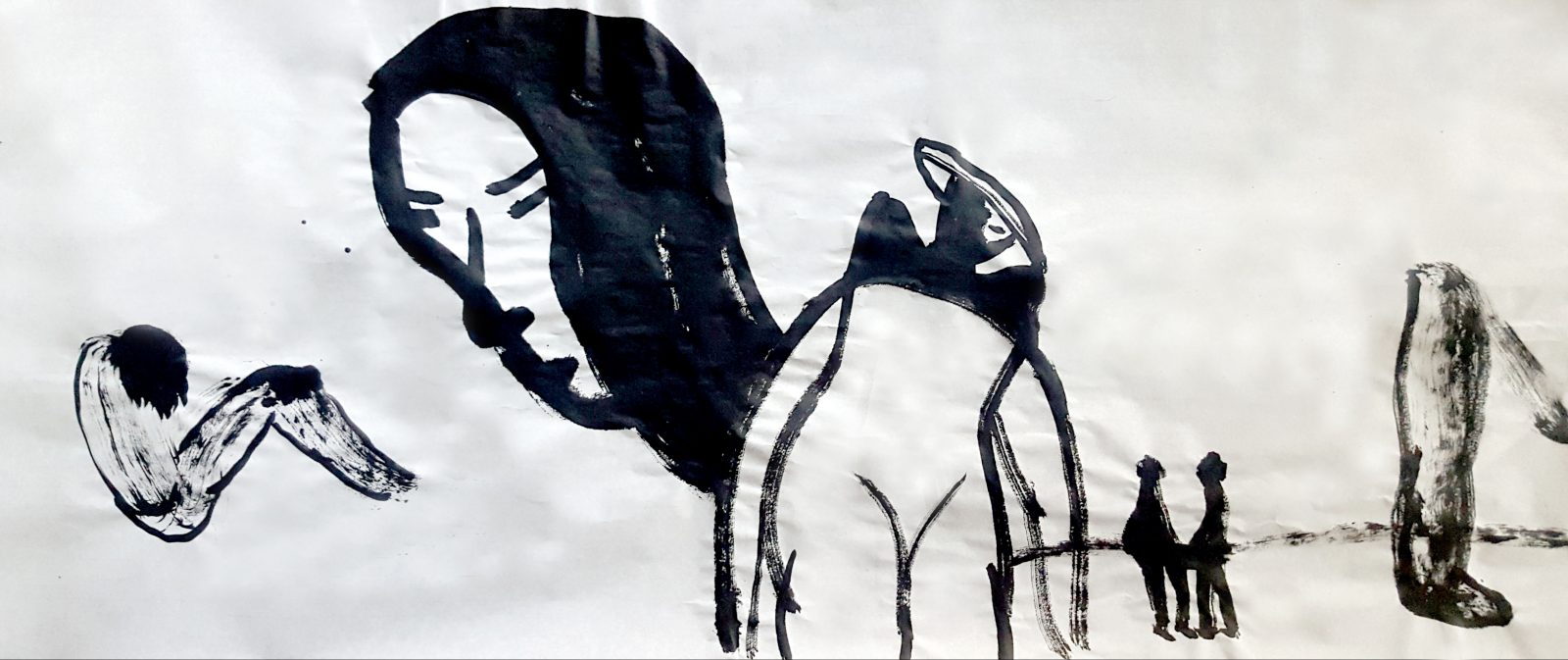
Yang Qi, lives in Dusseldorf. He started painting “Sleepless” at the beginning of the German lockdown and for 2 months he painted through the whole of every night, thus creating a 70m x 50cm Neo-expressionist painting that is dominated by only two colours: Black and White.
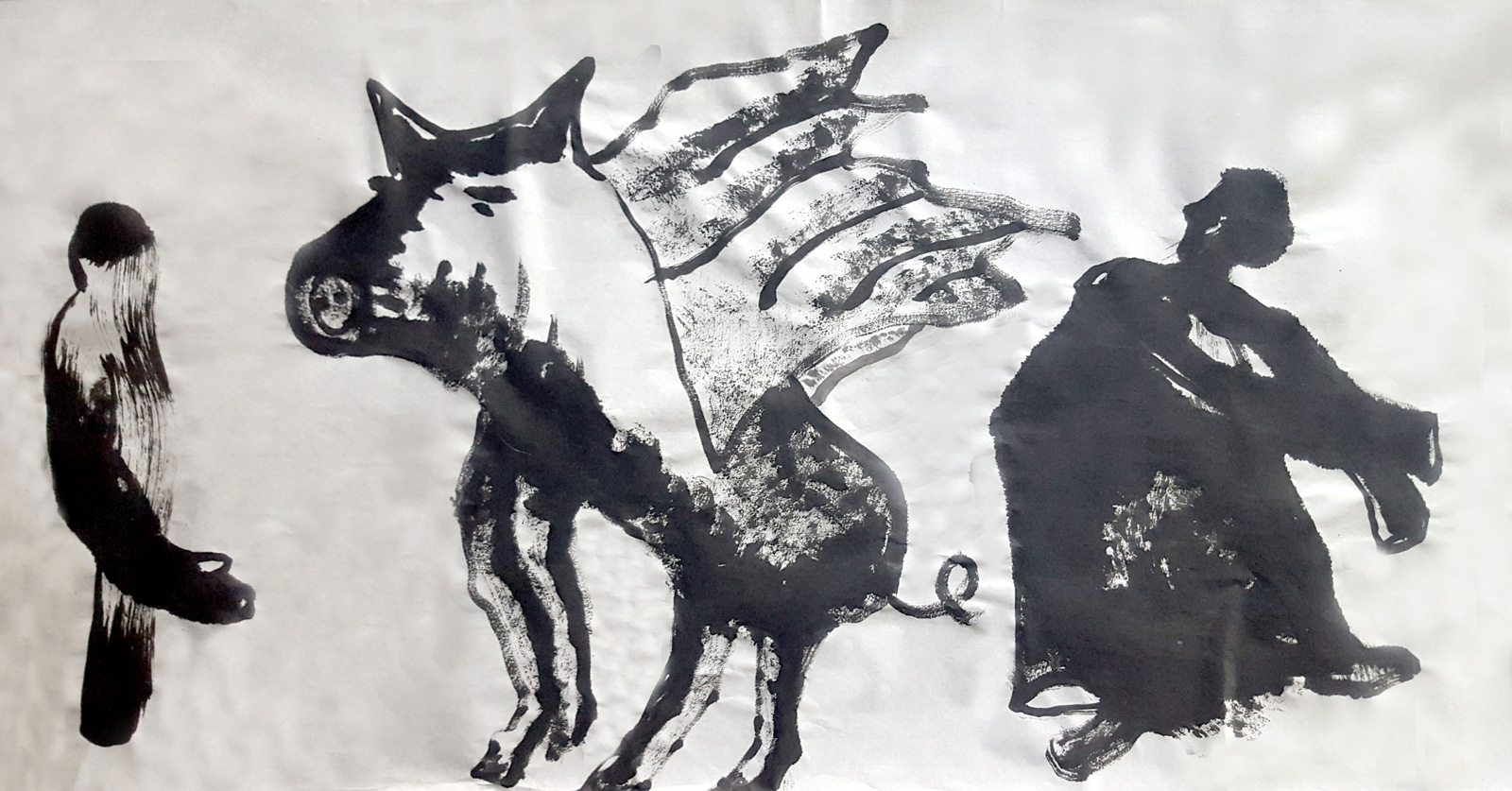
This is an absurd and surrealistic painting process, and it reveals Yang’s inner psychological activities during those nights. By only applying black and white colours he expresses the intensity and originality of his emotions, and coincidentally the contrasts that this creates also fit in well with Yang’s background, as an Eastern artist lives in the Western world for the last thirty years.
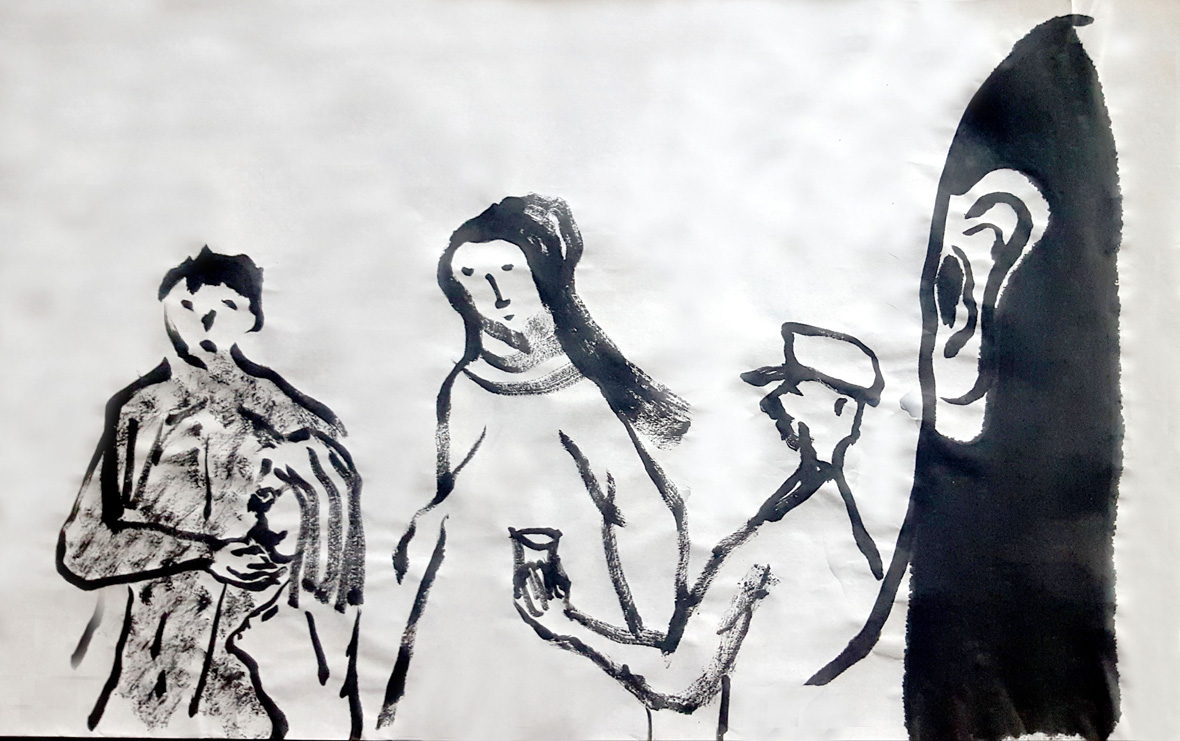
The painting is a labour of love, absurd, suspicious, unknowing, inspiring and dream-like, bringing us into a surreal world. During the Covid-19 pandemic we have seen so many people and countries that are in a state of isolation, even panic, and many people rightly feel nervous. In this kind of collective depression, as an artist, Yang Qi transcends the state of reality by engaging in a very interesting activity, which is a psychological activity of the artist himself, an activity which is confined to his own world, but also an activity that is art. By his nightly creations he has jumped out of our collective reality and when studying the painting you have to look at the world and what is happening through his mind, which he himself has fully immersed himself in. His mind is like the state of a game, so are his characters, his surrounding, his depictions, his performance, and they are all different from those of a realist. In his painting Yang Qi has expressed himself absolutely and unreservedly, his own unconscious activities, and through his subjective force, it can resist the current external interferences and disturbances.

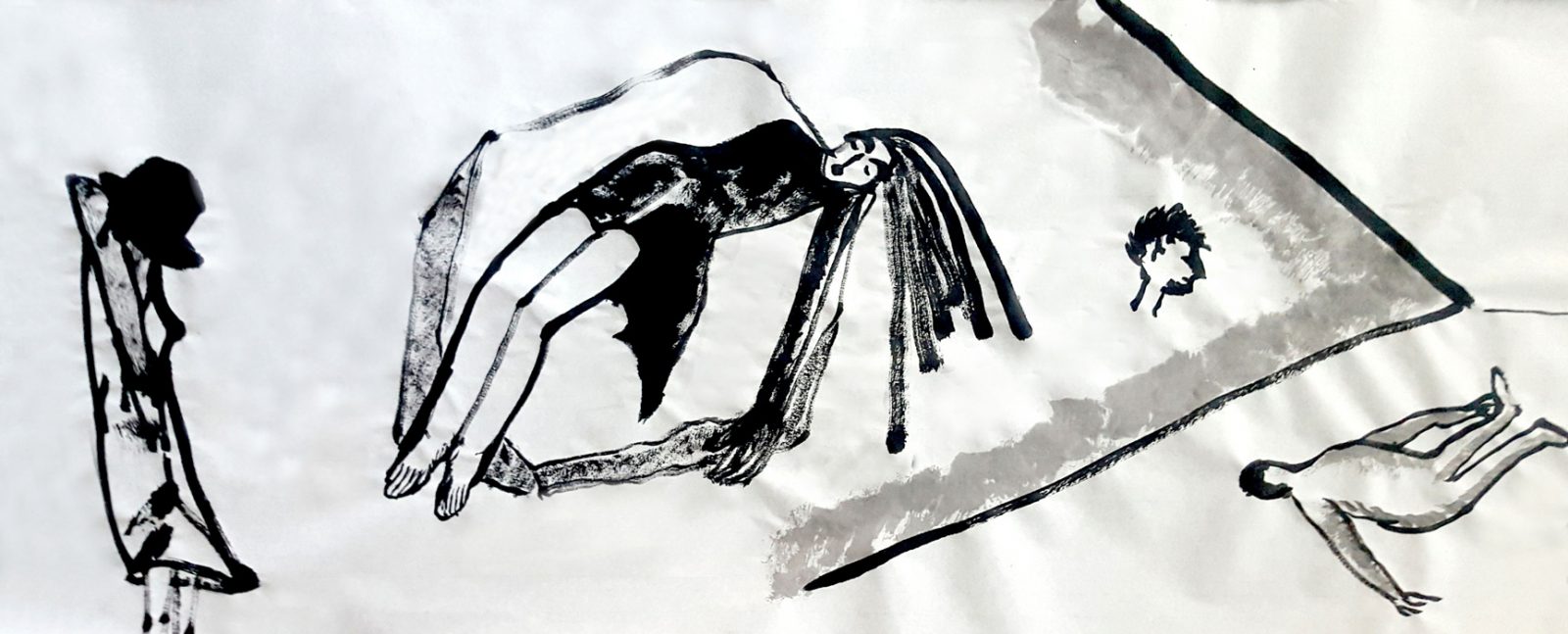

Read about more about Yang Qi.
“Then & Now: 2020 CAFA Online Graduation Season” was officially launched on https://art2020.cafa.edu.cn at 5:20 pm on May 20, the postgraduate thesis presentations were unveiled. On June 15, the Graduation Exhibition of Undergraduates will be unveiled.
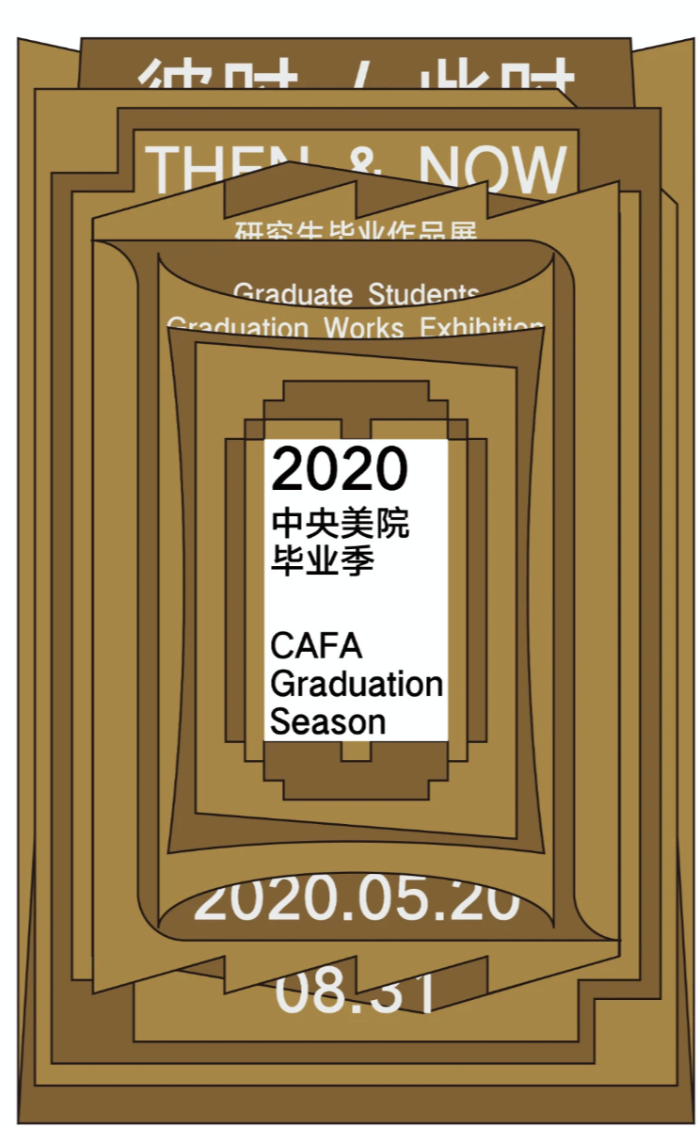
The “2020 CAFA Online Graduation Season” will present over 10,000 graduation works by 31 Ph.D candidates, 376 postgraduate students and 846 undergraduate students. The exhibition will be presented in 9 virtual galleries with a total area of 54000 square meters in the virtual art museum of CAFA. Over 20,000-30,000 works will be fully displayed in the form of web pages through the “hyperlink” of each student. More importantly, this is a “2020 Graduation Art Museum of CAFA” which will be fixed on the internet and will never go offline.

THEN & NOW, BIRTH IN SPRING & GROWTH IN SUMMER
—A Speech for 2020 CAFA Online Graduation Season, By Fan Di’an, President of CAFA on 20 May, 2020
The spring and summer of 2020 are destined to become a particular memory for all. The global pandemic of COVID-19 has aroused sadness in mourning the loss of lives and brave songs that fight to prevent and control the virus, all of which reverberate throughout earth. Confronted with such a sudden catastrophe, it seems hard for art to narrate the complicated situation but artists ultimately have affection and faith. The Central Academy of Fine Art (abbr. CAFA) has comprehensively conducted online teaching. With a joint effort from all the teachers and students, we overcome the difficulties caused by the pandemic through sincere artistic feelings and firm artistic obligations. We hold fast to the teaching positions, among which the most precious are the perseverance and endeavor of all graduating students and their supervisors. With excellent thesis presentations and achievements, they jointly won a collective glory for CAFA and a self-fulfilling journey for themselves. All of the thesis presentations therefore have their own unique connotations and testify to the national fight against the pandemic in artistic ways.
Ever since the establishment of “CAFA Graduation Season” in 2015, CAFA has established a grand talent festival of art by turning the campus into a great art museum. A broad platform is established for the display of works from diversified disciplines and schools of CAFA, and it further becomes a bridge to disseminate the achievements in talent training and promotes the employment and entrepreneurship of graduating students. Although 2020 CAFA Graduation Season cannot be implemented on-site at the CAFA Art Museum and other venues, CAFA has decided to use the online exhibition to present the talent shows of graduating students and repay the concerns of society. The complete preparation process was full of expectation and creativity.
Despite the rapid changes that occurred to internet technologies, there are no established rules for online art exhibitions and visual art galleries. In order to provide a comfortable display and appreciative experience as perfectly as possible, the curatorial team of CAFA and many teachers from various departments and schools have devoted great effort to this, NetDragon Websoft undertook the overall development of this project, nearly 100 employees have been working day and night and their endeavors make the grand exhibitions of the online graduation season become unique and fascinating. The works of graduating students presented in the spacious galleries of CAFA Art Museum, can be appreciated in an immersive way and visitors can change the scenery along their path while observing the momentum and subtleties. Visitors can also open up layers of links to enter the microcosmos of thought as created by each artist. The three-dimensional enrichment and expansion of CAFA Online Graduation Season has exceeded the existing level and added the latest experience to the social communication of contemporary art.

The pandemic has separated us from each other, but it cannot block our communication. The graduation season is the blossom season of the academy. In this year, it particularly sends out a message for firmness of faith and the strength of life. From then to now, from spring to summer, time and space, that and this, all make us feel warm and full of hope:
Then, it was a wonderful time to study in the campus,
Now, it is an exciting moment to enter society.
Then, having the dream of the ivory tower,
Now, walking into the earthly reality.
Then, filled with students’ enthusiasm, they cast all restraints aside,
Now, they are flourishing and striking trends and fads.
Then, youth was brilliant by grinding,
Now, life is sublimated by struggles.
Then, they knew the world through art,
Now, they reflect the world by art.
Then, they saw creations from beauty,
Now, they produce beauty from creations.
Then, the students looked forward to the glory of their alma mater,
Now, CAFA feels delighted with their achievements.
There are two main ways of viewing this online exhibition, namely with a mobile phone or computer. By clicking the link or scanning the QR code, you can enter the virtual venue. You can freely roam, jump, appreciate details, browse videos, play with models by clicking with the mouse or touching the screen of your cell phone. Various models and systems of computers or cell phones might cause different compatibility situations. Therefore, if you have difficulty in visiting it, you can try another device or refresh it.
After entering the virtual museum, visitors can choose any mode from “3D Virtual Graduation Exhibition” or “Online Graduation Exhibition”: if you choose the first one, you can virtually walk and visit the CAFA Art Museum by choosing the online galleries from 1 to 4 to gradually find presentations from various departments and schools; the “Online Graduation Exhibition” is more like an archive, through which you can intuitively understand the situation of thesis presentations from various departments and schools from graphic information.
More Ways to Play👇
🔍Search: Both viewing methods offer a chance to search and browse the work and thesis information by entering the name and student ID through the “search” function on the upper right corner.
➡️Share: Each page supports the function of “share” by clicking the graphic button of “arrow” to share the work with others.
👍Like: Click the red heart ♥️ at the bottom of the page, you can like the work and show your support.
We hope you enjoy this wonderful unique show!
Image Source: 3D Virtual Graduation Exhibition Hall Screenshot
@copyright by CAFA ART
Translated and Edited by Sue and Emily
This book, Rong Rong East Village, is about a group of performance artists in the East Village of Beijing in the 1990s, it records the life of their group and the reasons behind their art. It is a fascinating read, although it is about performance art, but the writing is very accessible.
Seeing pictures of these performance artworks and reading this book which records them made me yearn for those days, when artists instead of having money had a very strong aim, their goal being an artist, as well as an artist different from all other artists 
Thinking about the book now that I have finished it, I remember Zhang Huan who said, “I just came to Beijing, if I am not ruthless, how can others beware of my existence”. This group of artists: Zhang Huan, Ma Liuming, Zhu Ming, Duan Yingmei, Zuo Xiaozu, they were indeed ruthless in the ’70s. They boldly stated: anyone who continue painting is stupid, composing must not have a melody. Of course, these artists would later on become famous. But as I read the book I also found it a bit disappointing that the artists who do performance art generally don’t seem to pay much attention to the audience’s thoughts and feelings, almost exclusively focusing on their own, no matter what. For example, in 1991 there was a group exhibition with 16 artists in the National Art Museum, and each participating artist paid more than 10,000 RMB to the Museum, which was a lot of money back then. Just before the opening, Zhang Huan was wearing pants only and poured a bucket of blood coloured liquid on himself and ran into the museum, this performance titled “Angel’s tears”, resulted in the closure of the museum and the cancellation of the scheduled exhibition. As a consequence, all participating artists lost their money.


Zhang Huan became famous,the media love this kind of performance. Personally, I think that if an artwork is only aimed at grabbing the headlines, then that makes the artist selfish. But, fortunately, there were also a lot of performance artworks by this group of artists that became classic works in this field based on their own artistic merits rather than infamy. For example, the collective work “A meter higher for a nameless mountain”, Zhang Huan’s “12 square meters”, “65 kilograms”, “Raising the water level for a fish pond”, and Ma Liu Ming’s “Fin-Ma Liu Ming” and so on. At the time, these works struck the public’s vision like a sharp blade. Radical ideas must be “ruthless” if they are to break the model of secular cognition.


@ Zhanghua
Link to Part 1
The news continually reports COVID-19 daily on the TV and I think about it every day too. The focus is on numbers, the number of deaths. After a while my mind became numb and I didn’t feel nervous anymore. I played games for a few days, my eyes became sore, so I decided to find some books to read.
After reflecting on my works, I decided that I needed to systematically read some books on Chinese contemporary art, performance art, installation art and so on. I think if I want to make a breakthrough in my work, then I need to think outside of my box. The first book I read was Wu Hong’s “The Best Use of Everything, No Waste”.
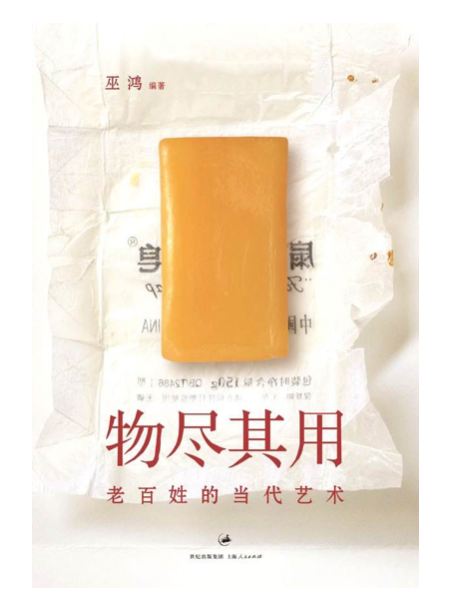
The book is about Song Tong’s installation titled “The Best Use of Everything – No Waste”. The artist’s father died unexpectedly which his mother found very hard to accept. She started to keep every used item in the house, no one was allowed to throw anything away. More and more things accumulate in the house, so Song Dong persuaded his mother to move them to a museum. Making the most of everything, no waste, was the philosophy of his mother’s generation. Through this exhibition, Song Dong’s mother starts to tell the story of each object to the audience, gradually his mother’s sadness subsides and smiles return to her face.
This book makes me believe there is life in each object, that’s why Song Dong’s mother didn’t just throw them away after use. Instead, she puts them in the museum. Such as a lighter, a mineral water bottle, a piece of soap and a piece of cloth. These ordinary and worthless objects are finally shown to people in the most dignified way in the museum. After being consumed by people, they survive in the most dignified way. Each of them has a life and a story. Many of the objects are decades old, and they are also witnesses of historical change. The exhibition was a healing experience for Song’s mother, who probably didn’t understand contemporary art. But, the show is more effective than any medical treatment for her, and that’s probably the value of art. It really can be therapeutic.
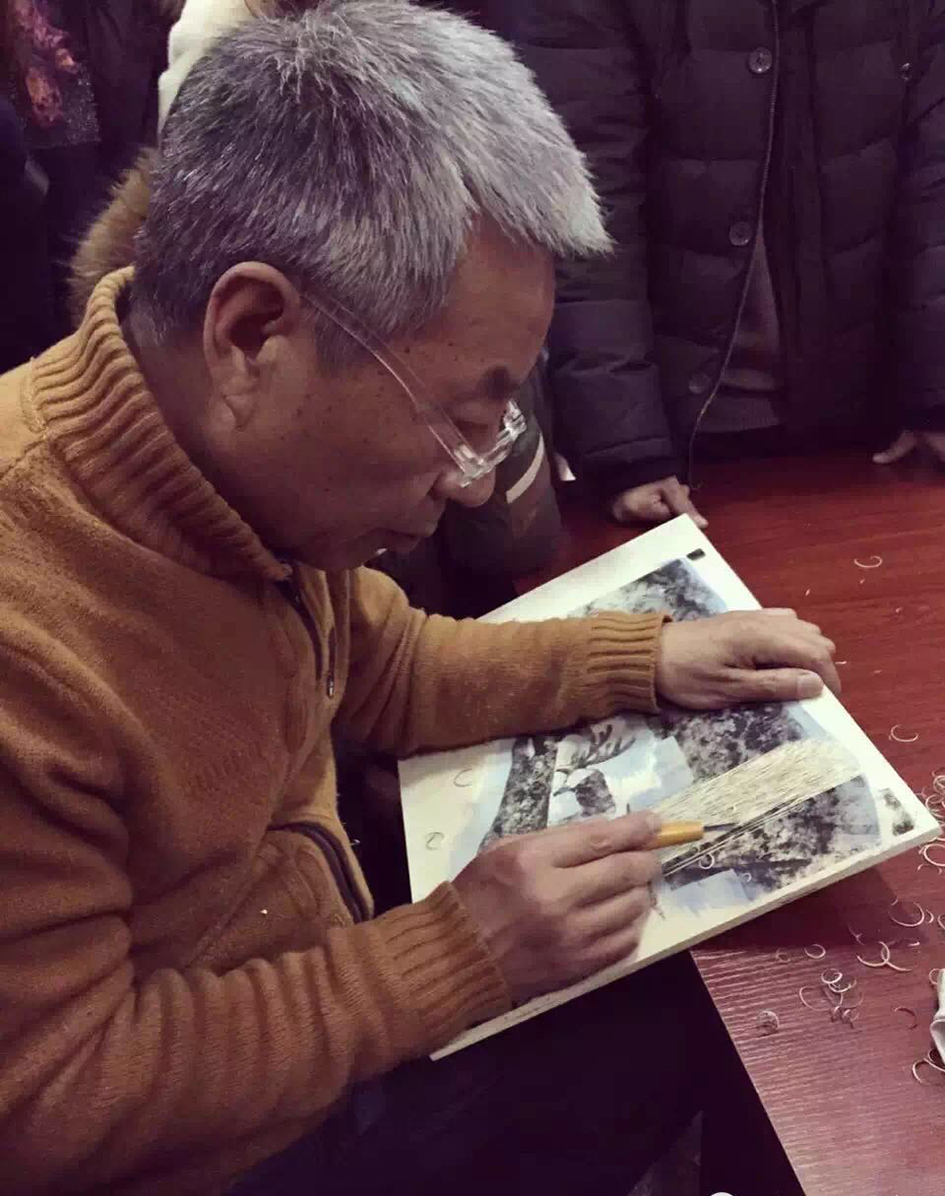
An air of serenity runs through Yu Chengyou’s prints, found in each delicate stroke and curve. His wonderful woodcuts show his vision of the Chinese landscape and the natural world with effortless grace.Words by Jake Kennedy, article in issue11 of Pressing Matters.
“For decades I’ve spent a lot of time every year sketching and collecting materials – I’ve almost walked through all the mountains, rivers and lakes in HeiLongJiang Provence.” YU CHENGYOU
Pressing Matters first encountered the peaceful serenity of Yu Chengyou’s prints via the ArtChina stand at Woolwich Print Fair in 2019. Their sense of space, contemplation and clear respect of the natural world was evident from every fern, blade of grass or cloud, truly taking the viewer to somewhere more relaxed – certainly more so than the busy print fair! Yu explains that this love of nature began way back in primary school, and with a simple act of mimicry. “I started out trying to imitate popular folk New Year prints,” he recalls. “The themes were always flowers and birds, vegetables and fruits and insects,” he adds.

Soon, Yu’s experimentation found him out in the country with his pad. “When I graduated from junior high school in early 1969 – during the cultural revolution – I became an ‘educated urban youth’ – I was 16 at the time – and went to work in the countryside and mountain areas. Together with others from Beijing, Shanghai, Tianjin and other cities who loved art, we drew everyday, but it was mainly portraits, life sketches – but without missing a single day. This practice built the foundation for me in the future… but the inspiration of my early creations mostly came from work and life in Beidahuang – every blade of grass and tree, the local folk and each passing season.”

Printmaking soon followed on from the sketching and observation in this artist’s life. “I studied printmaking in the early 1980s. I attended a course taught by Mr. Hao Boyi, one of the founders of Beidahuang printmaking,” Yu recalls. “During six years from 1982 to 1987, I spent about �three months every year learning printmaking. Beidahuang has been a most influential creative group in China since it was founded in 1958, incorporating a complete scheme of systematic printmaking research and teaching. Chinese critics call it the ‘real academy of printmaking” and it’s trained many dozens of outstanding Chinese contemporary printmakers. in 1978 I started to apply some of my landscape sketches on plywood and transfer into black and white woodcuts. So essentially my formal printmaking practice began in 1982, after I joined a BeiDaHuang printmaking class.”

Yu’s technique goes on at length to describe his printing process, forming the backbone of his output, you feel. “First, I have to select images from collected materials – which are mostly my own photos – sometimes using a few, or at other times dozens of them, and I decide how to create a particular print,” he explains. “Then I’ll draw several full size complete pictures to choose the best composition of a print, and this process will take five to seven days. Next, I transfer the drawing to the plywood, which is specially used by the printmakers. Generally speaking I need four to five blocks for a print, and each is cut separately. It takes 10 to 20 days to complete a colour print. I take about three or four attempts to get a good result, and then I’m ready to print.”

“I like to be quiet, and that’s maybe because of my personality.I try to keep my work peaceful.” YU CHENGYOU
Indeed, most of Yu’s prints are really just the result of a lengthy, involved process, with ideas set in place long before he even goes anywhere near the printroom. “For decades I’ve spent a lot of time every year sketching and collecting materials. I’ve almost walked through all the mountains, rivers and lakes in HeiLongJiang Provence, and Heilongjiang covers 473,000 square kilometres! I’ve taken over 200,000 photos. Except for Tibet, Qinghai and Xinjiang, I’ve been to almost all of the other places in China to sketch or paint nature,” he says. “I like to be quiet, and that’s maybe because of my personality. I try to keep my work peaceful. I use simple language and try to express things sincerely, to calmly communicate with the viewer. I think this kind of communication is more equal. To naturally express something is the artistic concept I’ve been pursuing in my works,” he adds.
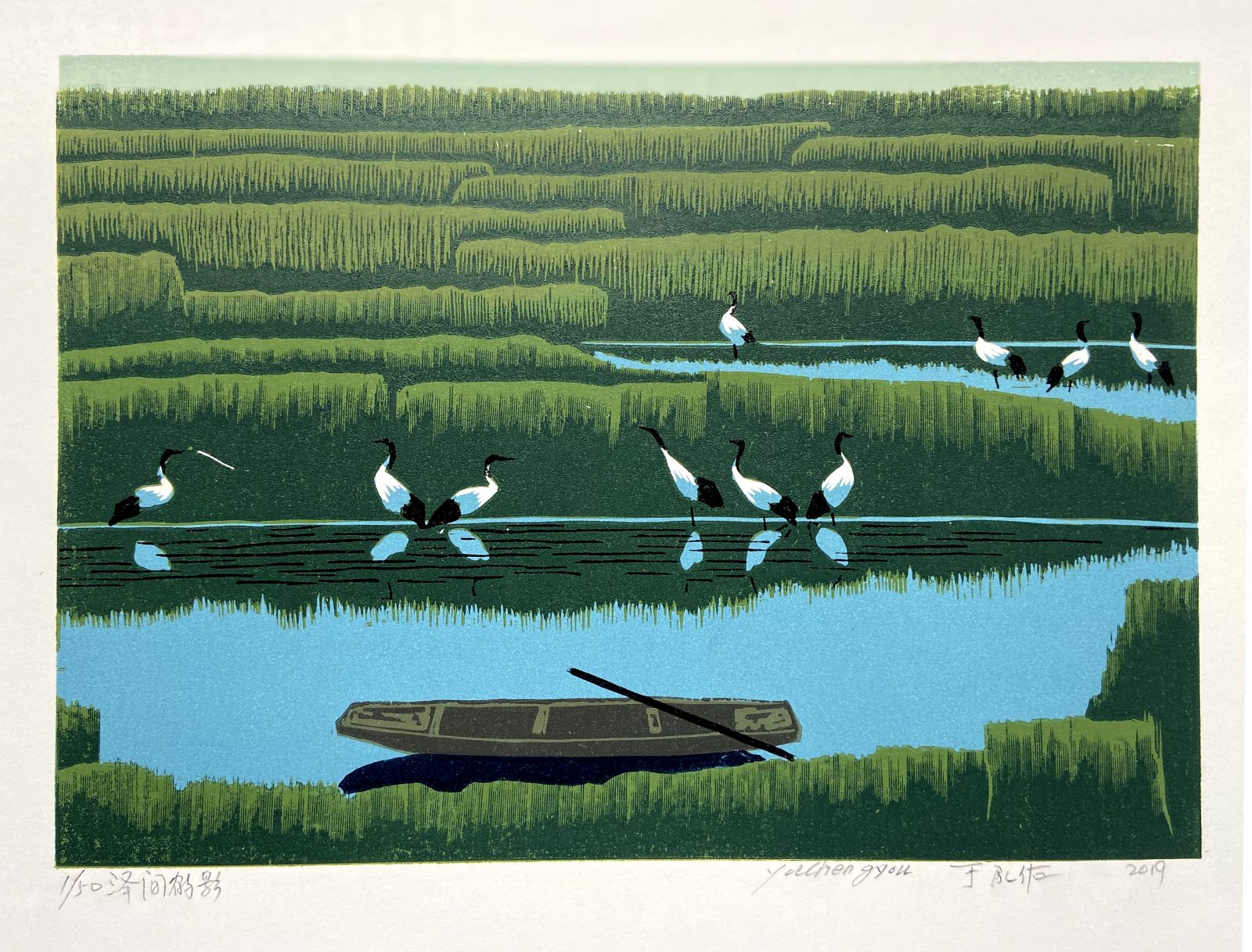
Again, Yu believes it comes down to a harmony in both the work and the nature he is representing. “A human is a part of nature. Humans should live in harmony with animals and plants in nature. I’ve always tried to express this harmony in my work, the feeling I’ve experienced after I’ve traveled to remote areas many times in the north of China – I want to capture this peaceful sensation with wildlife such as the reindeer and others.”
Another charming element of Yu’s prints is an often unusually high horizon line, allowing viewers to place themselves right in amongst the landscape of the pieces. “This allows for many expressive objects to be added into a work, but also
provides a much richer detail and a more completed narrative. The composition is based on the subject matter of the idea. However, for some of my other works I’ve done in recent years, I’ve lowered the horizon,” he says.
Yu’s work has been brought to the wider world by the ArtChina initiative, as mentioned earlier. “I have to thank Ms. Aimin Liu and ArtChina as she’s introduced my work to the UK since 2011, he says. “ArtChina show my works several times through its exhibitions in UK each year. However, in 2018 my biggest solo show, titled Clean Journey – Yu Chengyou’s Print Works, opened at the China print museum in ShenZhen.” Yu also had a touring exhibition that traveled the country in 2019 and will continue this year.
For now though, any remaining time left in 2020 is an opportunity for personal development for Yu, he hopes. “I plan to complete the construction of my personal studio and strive to build a better printmaking studio in China which will include all types of printmaking and the first class presses,” he says. “I’m also planning to create a series of prints to present the four seasons of spring, summer, autumn and winter using oil paints, watercolor and ink as a simultaneous creation, and I plan to print 60 of each edition,” he concludes.
Since 2002, Yu Chengyou has been working as a professional printmaker in Heilongjiang Printmaking Institute and is a member of China Artists’ Association. His print ‘The Night of a Small Village’ won silver medal at the 6th National Print Exhibition.
His prints are widely collected in China and abroad.
Special thanks to Aimin Liu from Art China for her invaluable help with this article.
Words by Zhu Jianhui, edit and translate by Aimin Liu.
The coronavirus broke out at the Chinese Spring Festival of 2020. As an artist I created 18 posters, prints and watercolours and published them online. I hoped to encourage people to fight against the virus through the visual impact.
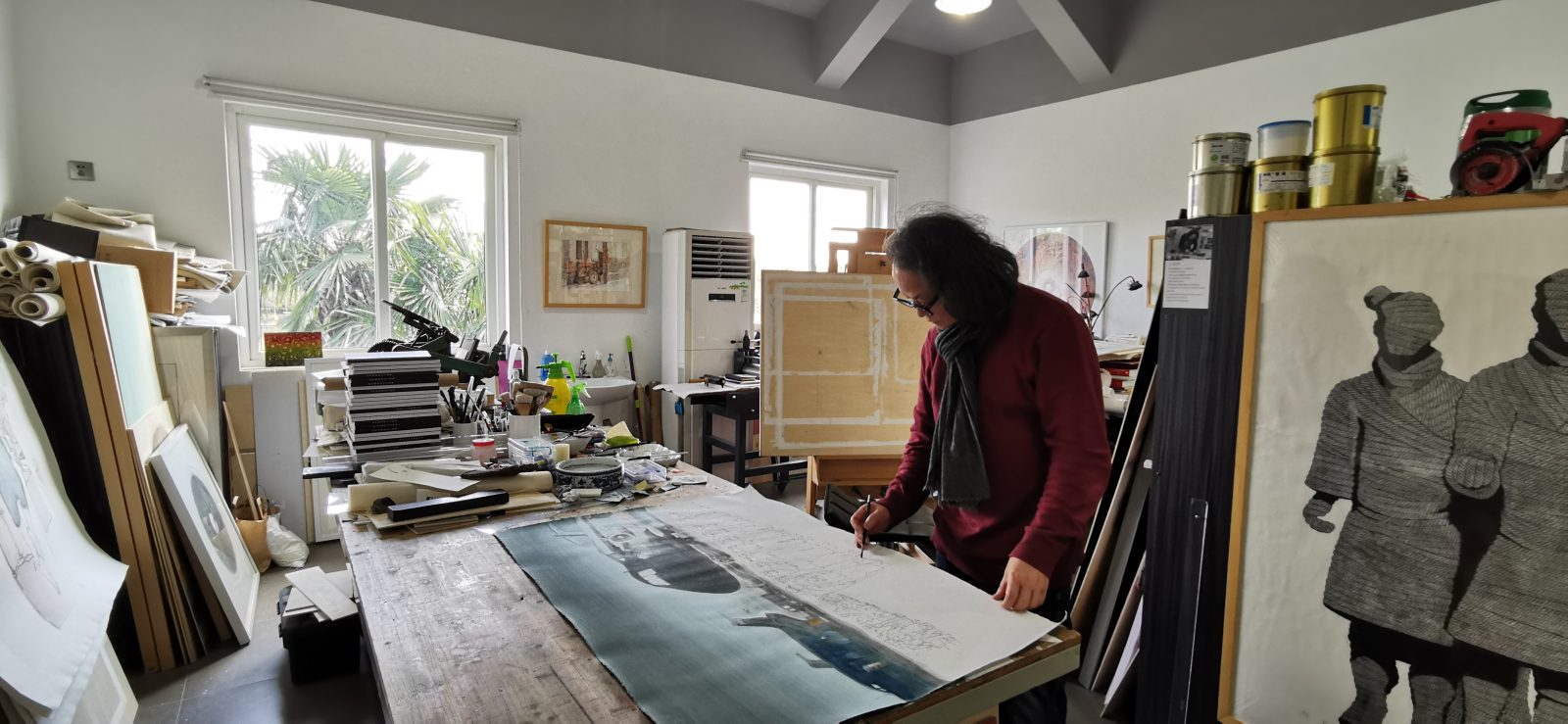 Zhu Jianhui at his studio in Qi Dong, Shanghai.
Zhu Jianhui at his studio in Qi Dong, Shanghai.
Music and my paintbrush are my companions in the voyage of creating a new artistic concept and discovering a different language for my art. During quarantine, I have created more than 20 water based woodcut and Chinese ink paintings.
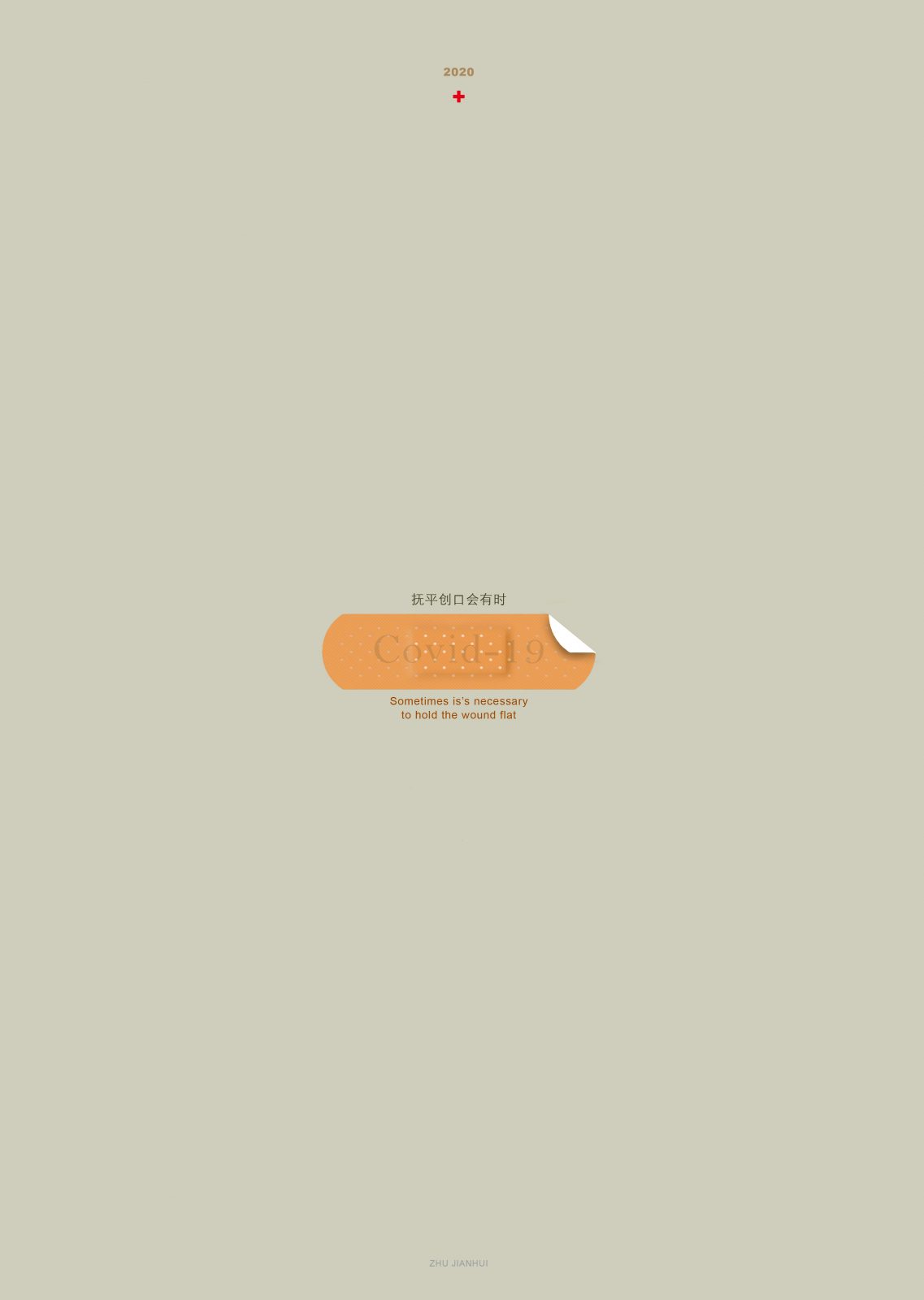 Sometimes it is necessary to hold the wound flat, Poster.
Sometimes it is necessary to hold the wound flat, Poster.
 My Eyes, water colours
My Eyes, water colours
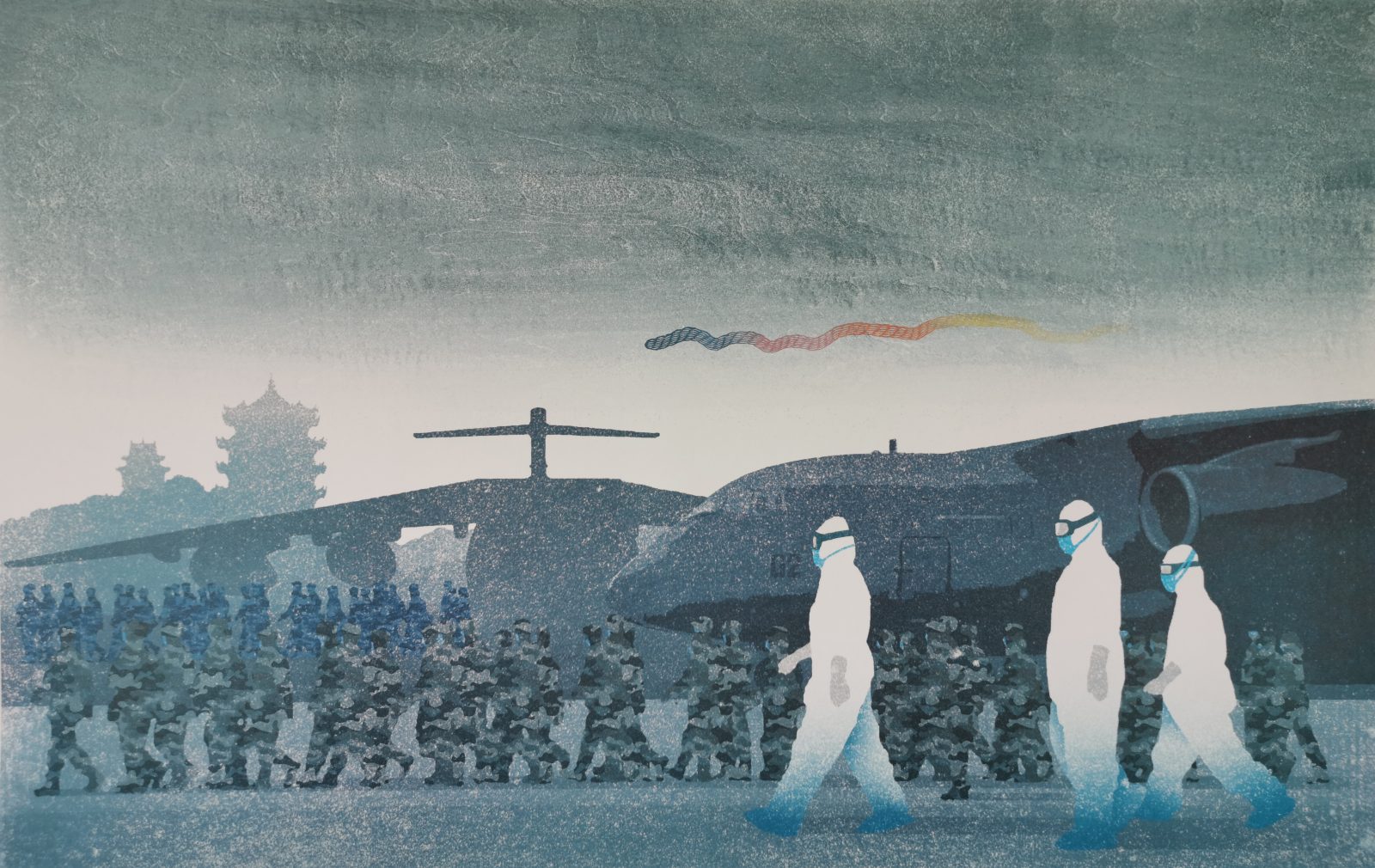 2020, water-based woodcut, 70cm x110cm
2020, water-based woodcut, 70cm x110cm
Staying at home, leisure time allows me to look back and think freely about my art. The series of water-based woodcuts “Magic Cube” and the series of experimental ink painting “Cube” are the new narration and expression of my artistic concept.
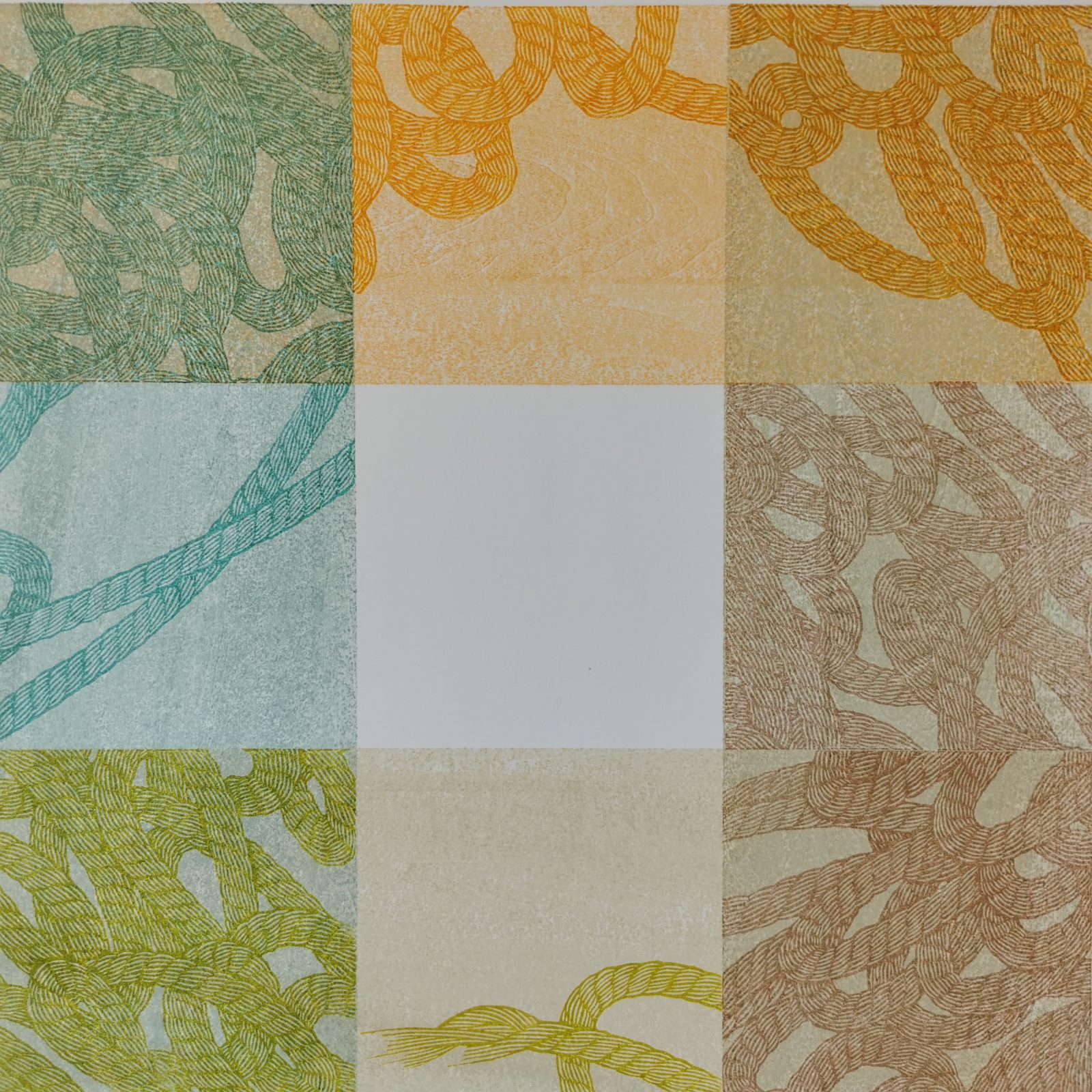 Magic Cube II, Water-based woodcut.
Magic Cube II, Water-based woodcut.
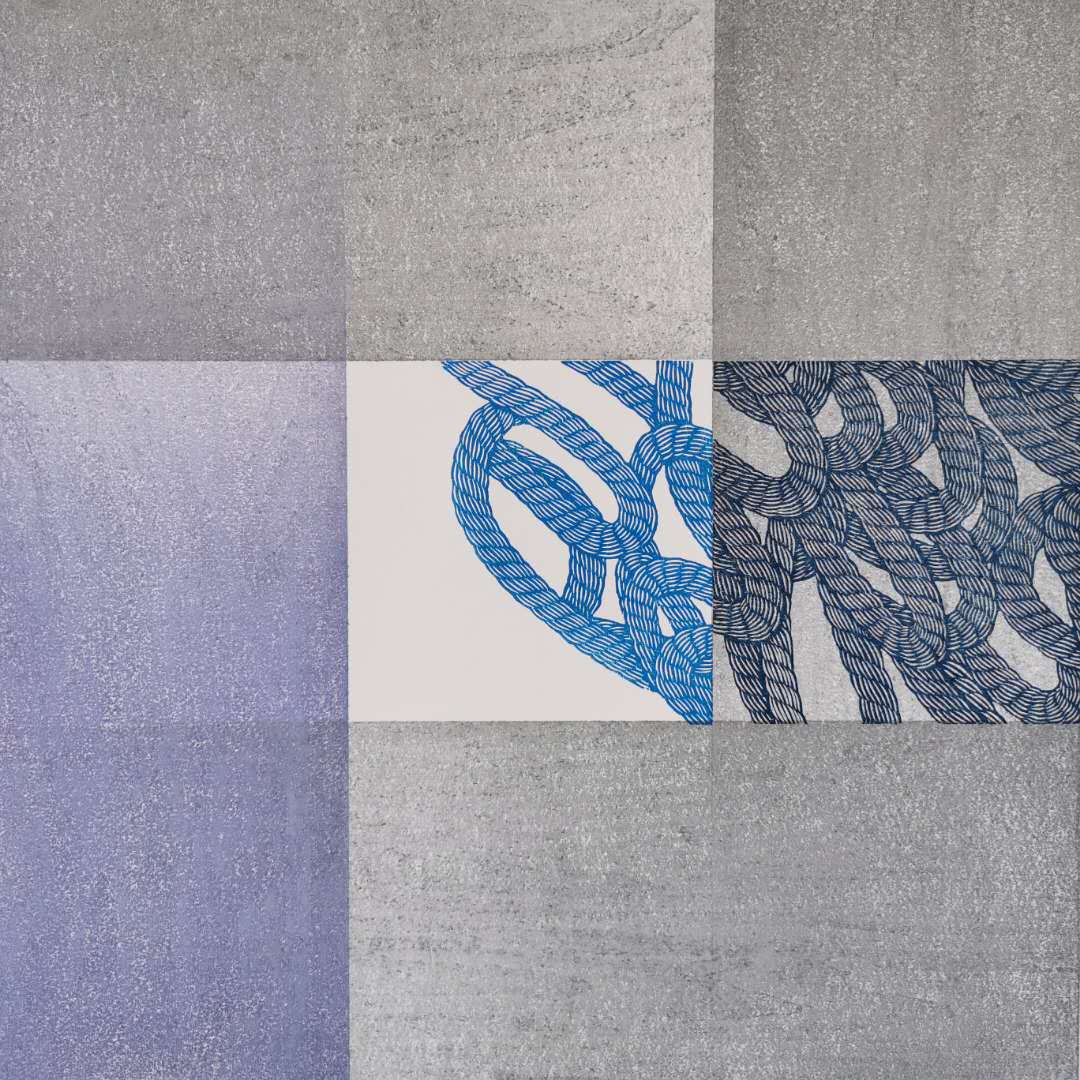 Magic Cube IX, Water-based woodcut.
Magic Cube IX, Water-based woodcut.
The “Magic Cube” series runs through the whole process based on rebuilding structure and it has a new way of expression. I constantly reshaped the combination of the Rope symbol and colour, then printed it on paper. And I continually illustrated it with the combination of “Cube” to narrate stories in ink painting.
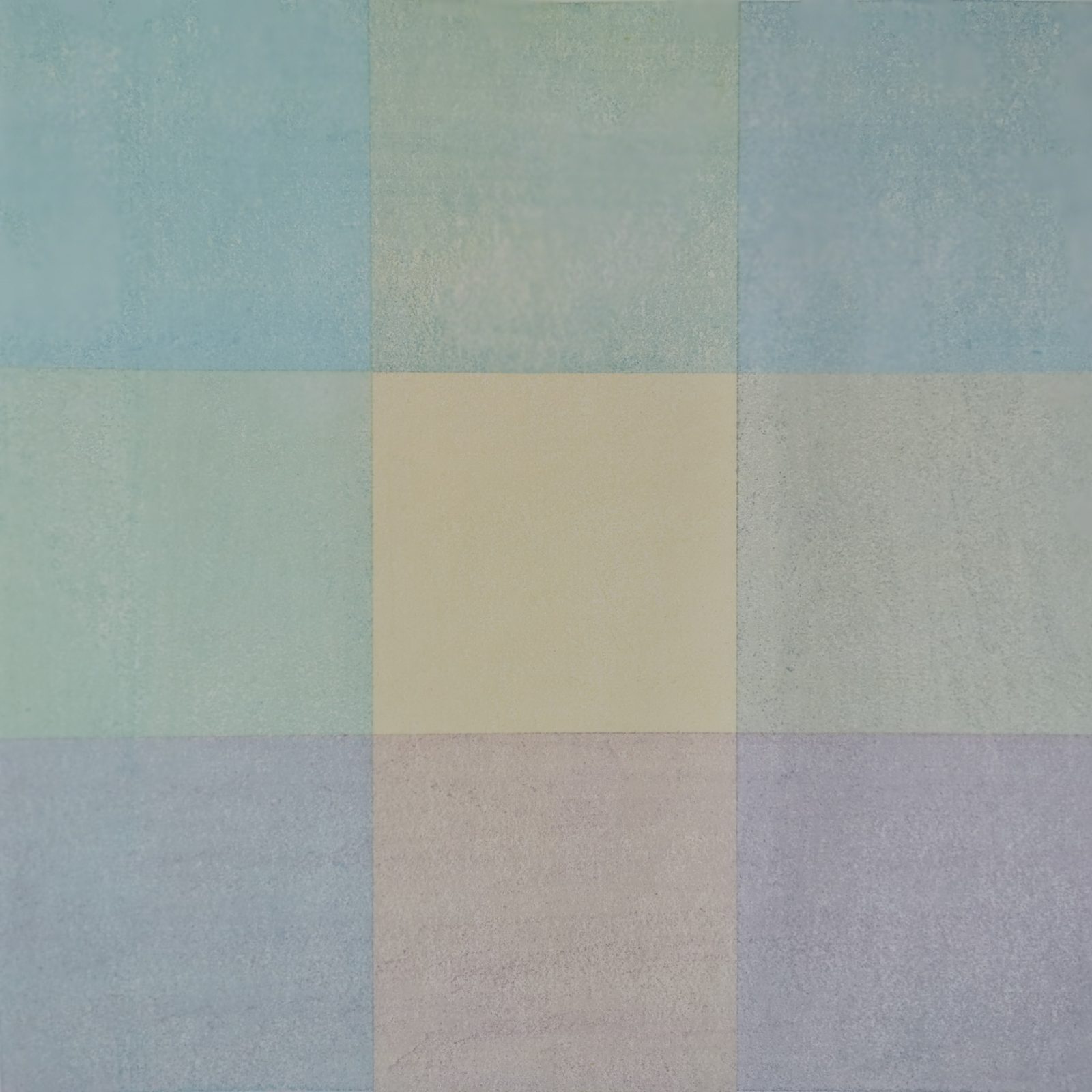 Magic Cube XIV, Water-based woodcut.
Magic Cube XIV, Water-based woodcut.
Water based woodcut and Chinese ink painting are two different organisms, they differ in their technique and format, but both are traditional art forms and have roots deep in our culture. So, they can be blended as well as exist independently.
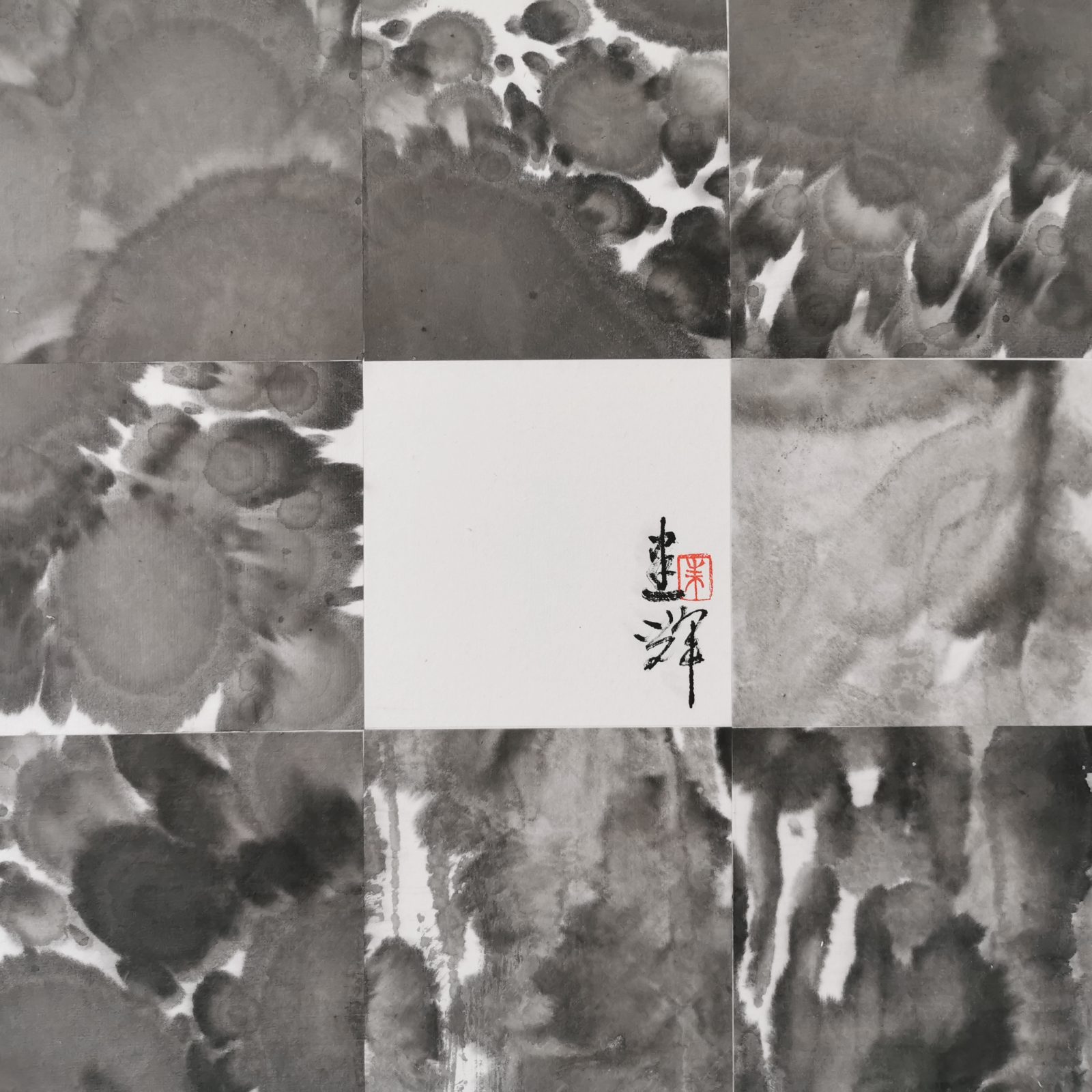 Cube II, Chinese Ink Painting
Cube II, Chinese Ink Painting
I enjoy the alternate use of the two art forms, such as “Five Colours of Ink” and “Vivid Charm”. The world is always full of contradictions, the perceptual ‘Magic Cube’ is presented rationally in the print, and the rational ‘Cube’ is painted in a perceptual form.
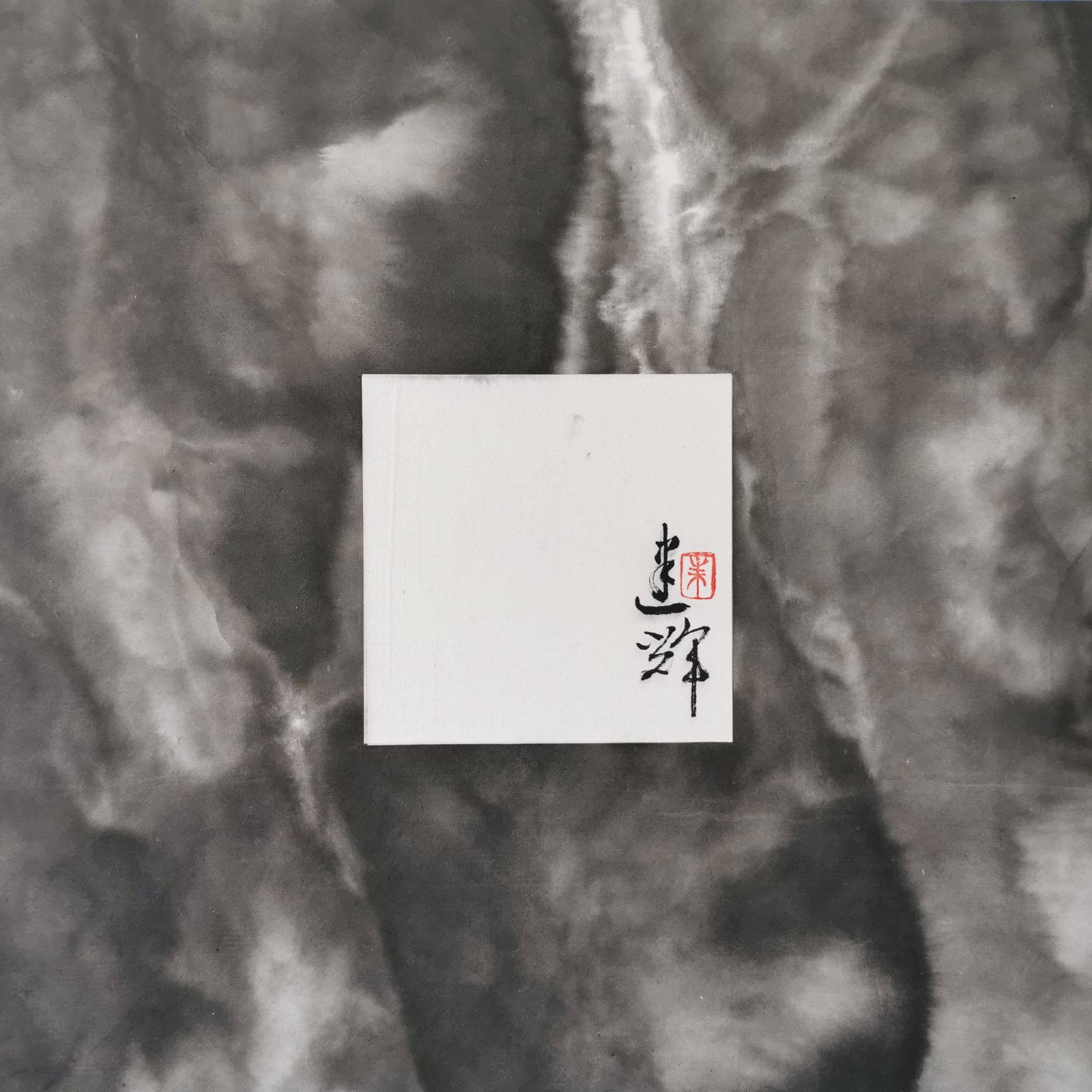 Cube X, Chinese Ink Painting
Cube X, Chinese Ink Painting
Starting from the minimalist, then adding repetitive work and the unconscious psychological experience into a visual form. The abstract expression is the consciousness of the artistic concept. It’s also a new way to express which I’m looking for while staying at home.
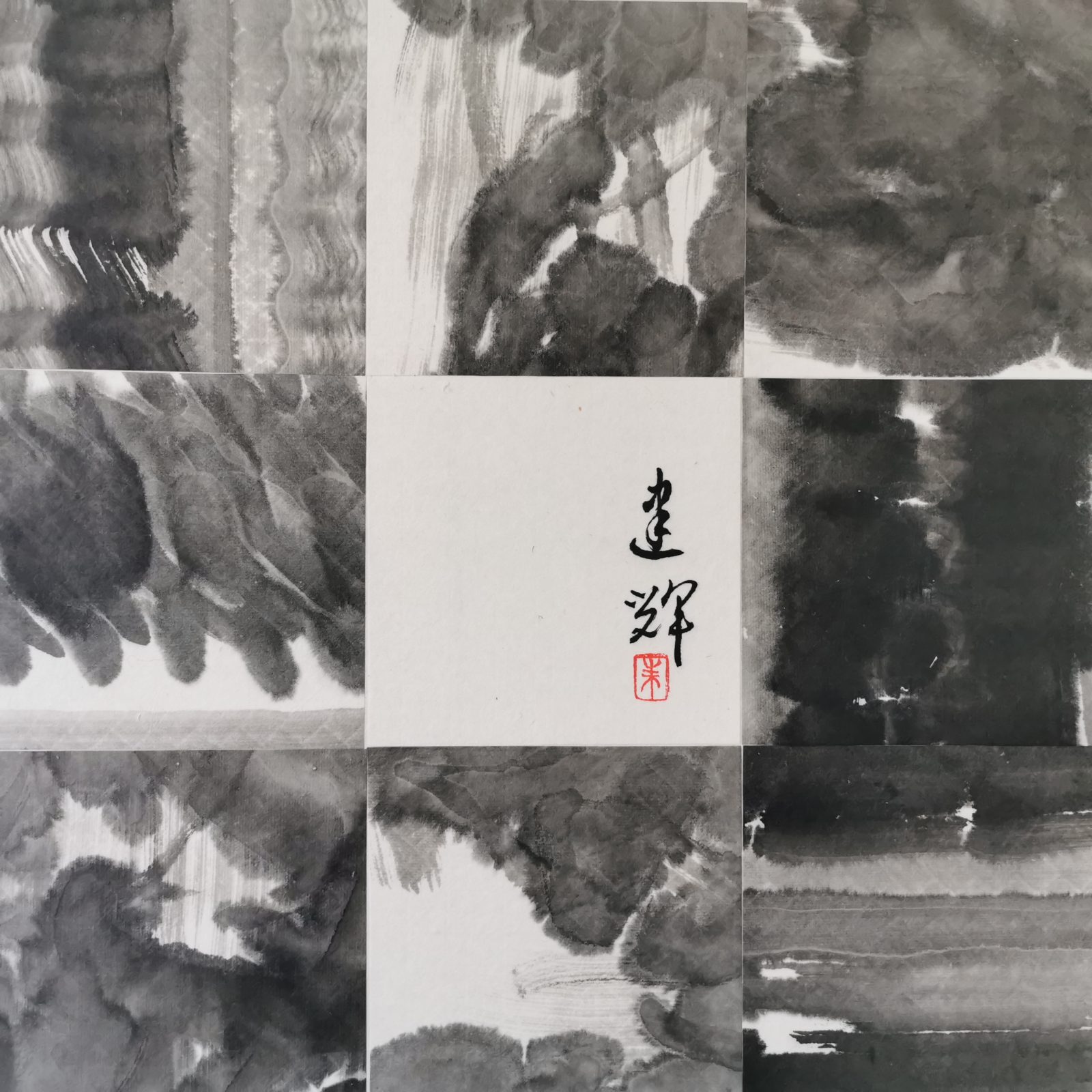 Cube IX, Chinese Ink Painting
Cube IX, Chinese Ink Painting
May the world be in peace! Everyone stay healthy and well!
万众一心,携手抗疫
Joined hands to fight the virus
前言 Introduction
因CONVID-19的影响,全球大众皆处于水深火热之中。在这次危难中,我们看到了大自然的权威、生命的脆弱、健康的重要及人性的复杂,我们收获了敬畏、团结、自律、感恩、责任、奉献、信任、勇敢、正直、关爱及思考……
People across the world are going through a difficult time due to the outbreak of CONVID-19. In this we’ve seen the authority of the nature, the fragility of lives, the importance of health and the complexity of human nature. It also gives us reflection on reverence, solidarity, self-discipline, gratitude, responsibility, dedication, trust, courage, integrity and caring.
病毒不分国界、不分种族、不分地位与性别年龄,它是我们共同的敌人。正是在这场战“疫”中,我们隔离在家静心学习反思,勇者们冲锋向前为我们遮风挡雨,社会各界齐心协力共同应对,幸甚国内疫情现阶段已经得到一定的控制。
Virus knows no boundary, race, status, gender nor age, which makes it our common enemy. While we are staying home in self-quarantine, there are brave soldiers fighting the virus in the front line and trying their best to protect us from it. With joined efforts, the epidemic in China is now under control.
这段时间我们看到了全国人民与世界各地不同的国情及不同的举措,听到了不同的声音,是认同亦或是非议,我们都值得反思缘由,人无完人,国亦如此。这几天有看到方方日记海外出版的消息,感触良多,正如盲人摸象,我们判断任何一件事物都不建议片面、单向、局部来了解与判定。事情的真相,需要从不同的人眼里,不同的角度来探索。
In this time we’ve witnessed different measures taken by different countries in the world, and heard different voices which are worth listening and reflecting on, both voices of approval and voices of criticism. No man is perfect, nor is any country. Seeing the journal of Fang Fang being published overseas, mixed feelings arise. We can’t judge things without knowing the whole picture, especially not with bias. Truth can only be shown from different angels and by different people.
因此,我们来自全国9个不同省市的艺术家联合在疫情期间,条件有限的情况下,自发共同创作了这副“万众一心,携手抗疫”沙画视频,并邀请旅意女高音歌唱家叶璐参与配音,译成中英双语,旨在向全世界人民展示疫情下的中国,希望通过我们的作品让全世界人民能够从不同的角度、不同的人群,更全面、客观的了解真正的中国!同时呼吁世界各国万众一心,携手抗疫。
For that, Nine artists from different provinces of China have voluntarily created this video together with limited conditions and invited famous singer Ye Lu as the voice. With this bilingual video, we intend to show the world what China is like under the epidemic, and hope that it can help people from different countries and regions see the real China comprehensively and objectively from different perspectives. Let’s join hands and fight the virus together.
正如英国女王4月5日非常规电视演讲中提到的:美好的日子将会归来;我们还会和朋友相聚;还将与家人团圆;等我们再相见!
As Queen Elizabeth II said in her televised speech on April 5th: better days will return; we will be with our friends again; we will be with our families again; we will meet again.
地球村再相见!!!
We will meet again!
Script of the video:
“中国人总是被他们之中最勇敢的人保护得很好。”基辛格
Chinese people are well protected by the bravest among them.
2020年01月23日,武汉封城。
January 23rd, 2020, Wuhan City was locked down.
钟南山赴武汉 An Academician who rushed to Wuhan
17年前带头抗击非典,84岁的钟南山院士,17年后又从广州奔赴武汉。
Led the fight against SARS 17 years ago, ZHONG Nanshan, an academician of the Chinese Academy of Engineering, 84 years old, has once again stepped forward and rushed to Wuhan from Guangzhou to fight in the front line.
“哪有什么岁月静好,只不过是有人替你负重前行”
“Peaceful times are only possible because of those who shelter us from the storm.”
白衣天使请战书 A Petition to join the battle
祖国有难,白衣天使们自动请战。
When our country was in need, the Angels in White (the doctors and nurses) asked for assignment to join the battle voluntarily.
“可不可以别告诉我妈妈,她会担心!”
“Could you keep it from my mother? she’ll be worried!”
“不计报酬,不论生死”
“With no consideration for payment or even their own safety.”
哪有什么白衣天使,只不过是一群孩子换了一身衣服,学着长辈的样子救治病人,和死神抢人罢了!
There is no Angles in White, they are just some young people changed into medical uniforms, who endeavor to save lives and fight against Death, like their elders do.
5.12汶川地震幸存女孩留武汉做志愿者 A girl who stayed in Wuhan as a volunteer
5.12地震幸存女孩,瞒着妈妈留在武汉,报名参加了社区保障车队,成了为社区2000多居民和患者提供免费出行服务的“摆渡人”。“只要我们众志成城,就一定能够战胜疫情!”
A girl who survived the 2008 Wunchuan Earthquake in Sichuan Province chose to stay in Wuhan and joined the logistics team in her community to provide free transportation service for more than 2000 residents and patients, without telling her mother. “As long as we fight together, we will triumph over the virus!”
一位妈妈给儿子的一封信:要活下来 A letter from a mother to her son: Stay alive
武汉一位老人,为了给已确诊的儿子要到一张床位,独自在医院守了整整五天五夜。当儿子终于送进病房,老人要来纸笔,给儿子留言:“要活下来。”这位老人90岁,而她的儿子,65岁。
In Wuhan, an elderly stayed in the hospital alone for five days and nights just to wait for a vacancy in the hospital for her infected son. Right before her son was taken into the inpatient ward, she asked for a pen and wrote to him:”Stay alive.”She was 90 years old and her son was 65.
“生命摆渡人”顺丰小哥汪勇WANG Yong, a deliveryman from SF Express, is called “Ferryman of Lives”.
从独自一人接受金银潭医院医务人员上下班开始,他一步步搞定金银潭医护的出行、就餐问题,带领一群自发组织起来的志愿者,团队共对接1000名医护人员,义务包揽起金银潭医院的后勤服务,“只要呼唤我,我随时都在”。汪勇说:“疫情过后如果我们都安好的话,我希望能多陪陪家人”。其实哪里有什么从天而降的英雄,这场疫情国难里,有的都是挺身而出的普通凡人。
WANG Yong, a deliveryman from SF Express, is called “Ferryman of Lives”. He voluntarily took on the commuting of the medical staff in Wuhan Jinyintan Hospital by himself, and then their transportation and meals, and later gathered a group of volunteers to support more than 1000 doctors and nurses and provide logistics service in the hospital. “I’m always here whenever needed.”WANG Yong said, “I’d like to spend more time with my family when this is over.”All the heroes in this battle are just plain human who choose to stand up and fight.
娃娃要抱抱 A hug
一个被感染被迫隔离的娃娃,隔着窗户找护士要抱抱,护士顿时泪崩。
An infected infant in the quarantine room reached out trying to get a hug from the nurse. She burst into tears outside the window.
当爱情遇到疫情 A promise (When love is caught by the virus)
90后的小情侣,准备在春节结婚。可当爱情遇到疫情,爱情被默默藏在心里,他们为支援武汉推迟了婚期,二人戴着口罩隔着玻璃窗相望“亲爱的,等疫情结束,我们就结婚!”
A young couple was going to get married during the Spring Festival. When the virus struck , they had to put their love away and postpone their wedding in order to fight for Wuhan. Seeing each other across the window with their masks on, they said: “my love, let’s get married when this is over.”
吹哨人李文亮医生去世 A Whistle-blower: Dr. LI Wenliang passed away
这位勇敢却值得尊敬的医生,在武汉疫情的紧要关头,仍然坚守在一线上。哪怕被病毒感染,乃至进入重症监护室,他也乐观地面对生活,并且在病房当中他依旧向大家表示:等他病好之后,依然要返回一线。我们迫切希望奇迹能够发生,但是最终我们却等来了一个不好的消息,2月7日凌晨,“吹哨人”李文亮最终去世,我们期盼的奇迹却没有发生。
Dr. LI Wenliang, a brave and respectable doctor, fought in the front line during the most crucial time in Wuhan. Even when he was infected and sent into ICU, he kept a positive attitude and said that he would come back and fight again. We desperately hoped for a miracle. Yet a horrible news came. In the early morning of February 7th, the whistle-blower Dr. LI Wenliang left us. The miracle didn’t happen.
中国奇迹,10天建好火神山医院 A Wonder of China: 10 days to build the Huoshenshan Hospital
因为疫情,武汉火神山医院从1月24日立项,到2月2日正式交付,10天10夜的时间建成一座具有1000张床位的现代化医院,期间全国4000万人在线监工。。。
Because of the virus outbreak , Wuhan Huoshenshan Hospital project was established on January 24th and the construction was completed on February 2nd. It took China 10 days and nights to build a modern hospital with a accommodation for 1000 people, during which 40 million people “supervised” online.
这就是中国速度,很多人称中国是基建狂魔,其实哪有什么基建狂魔,不过是一群不辞辛劳不分昼夜的人罢了。
This is the speed of China. Many people may think China is“infrastructure-holic”. It’s only possible because of a group of people who go all out and work from day to night.
清洁工老人匿名捐赠12000元 An anonymous donation of 12000 yuan
一位戴着卫生帽的老人将一张纸和12000元放在派出所的柜台上,转身离开,监控录像捕捉到了这一瞬间–这位老人今年68岁,是村里的清洁工。
An elder man with a sanitary hat put a piece of paper and 12000 yuan on the counter of the police office and left. A surveillance camera caught this–he was 68 years old, a janitor in this village.
疫情牵动着每个人的心扉
It concerns every single one of us.
人民子弟兵 The people’s army
“若有战,召必至!” 疫情就是命令,大年三十,在战“疫”关键时刻,人民子弟兵逆行奔向最危险的战场。
“We’ll be there whenever called for during a war.”The outbreak was like an order. In the crucial time a day before Chinese New Year, the people’s army reached the most dangerous battlefield in Wuhan.
全国各大医院全力支援 Full support from hospitals across the country
“北协和、南湘雅、东齐鲁、西华西”中国医疗界的四大王牌军会师武汉。共来自全国31支医疗队,共4万多人支援武汉,其中0感染。
Xiehe from the north, Xiangya from the south, Qilu from the east, Huaxi from the west, these four top hospitals in China joined efforts in Wuhan. 31 medical groups from across the country, more than 40 thousand people, joined the fight in Wuhan, and none of them was infected.
海外华人 support from overseas Chinese
海外华人及学子捐赠抗物资,免费包机直送祖国疫区
Overseas Chinese and students donated medical materials and chartered a plane to deliver them directly back to China.
世界各国捐赠 Donations from other countries
山川异域,风月同天。岂曰无衣,与子同袍,世界各国纷纷援手中国。
Despite the variation in landscapes, we share the same sky and moon, so together we stand in times of difficulty. A great number of countries have showed their support to China.
浦东机场严防境外输入Shanghai Pudong International Airport,strictly prevent the virus importation from overseas
作为中国最大的“空中走廊”,每年平均接待旅客近5000万人次的浦东国际机场,今天已成为我国防控境外疫情的前线和主战场。”严防境外输入!守护我的国!移民警察化身大白,全副武装奔赴战场,他们义无反顾!身边是战友,身后是祖国,他们并肩作战,他们是凡人,他们也是英雄。
As the largest “air corridor” in China, Shanghai Pudong International Airport can accommodate 50 million passengers annually, and has become the front line and main battlefield against the epidemic. “Strictly prevent the virus importation from overseas and guard our country!”Chinese policemen put on their outfits and went off to this special war with no hesitation, like Baymax. They are fighting together with their friends and for their motherland. They may be plain human, but they are our heroes.
张文宏医生Dr. ZHANG Wenhong
讲真话、办实事、有担当的张文宏医生,他身为上海华山医院感染科主任,在这次疫情中,每周都会去隔离区查房,为的就是消除一线医护人员的恐惧。“
Dr. ZHANG Wenhong, director of Infections Department in Shanghai Huashan Hospital, who is candid, practical and reliable, checked on the patients in quarantine in person every week in order to lift the concerns of the medical staff who worked in the front line. “
携手抗疫 Hands in Hands to fight the virus
病毒无国界,现在海外疫情严重,同一个地球,同一片天空,让我们共同一心,携手抗疫!
The virus knows no border. In this time of massive outbreak overseas, let us join hands and fight the virus to protect this planet we share.
出品:中华文化促进会苏州代表机构, 中国沙画家协会,上海协申联合企业大学艺术人文学院, Artchinauk, 予艺艺术
Presents: Chinese Culture Promotion Society(SuZhou), Sand Painters Association of China, College of Arts and Humanities of Shanghai United University, ArtChinauk,Yuyi Art
Our whole family drove back to my hometown in Shandong just five days before Chinese New Year’s Eve in 2020. We saw the news about Wuhan’s pneumonia on our phones. The report said it was not serious. I didn’t even watch the news and only heard a few words about it from the family.
My studio
We stopped a few times in the services on the highway during our journey. The services were busy, and nobody was wearing a mask. It surprised me how many people went back home much earlier, and there were not so many people around this time as in previous years. It usually gets crowded 2 days before the New Year. Normally this is a 12 hour journey, but it took us over 16 hours because of the traffic. It was ok for us, but my poor cat suffered as it couldn’t go to the toilet for the whole duration.
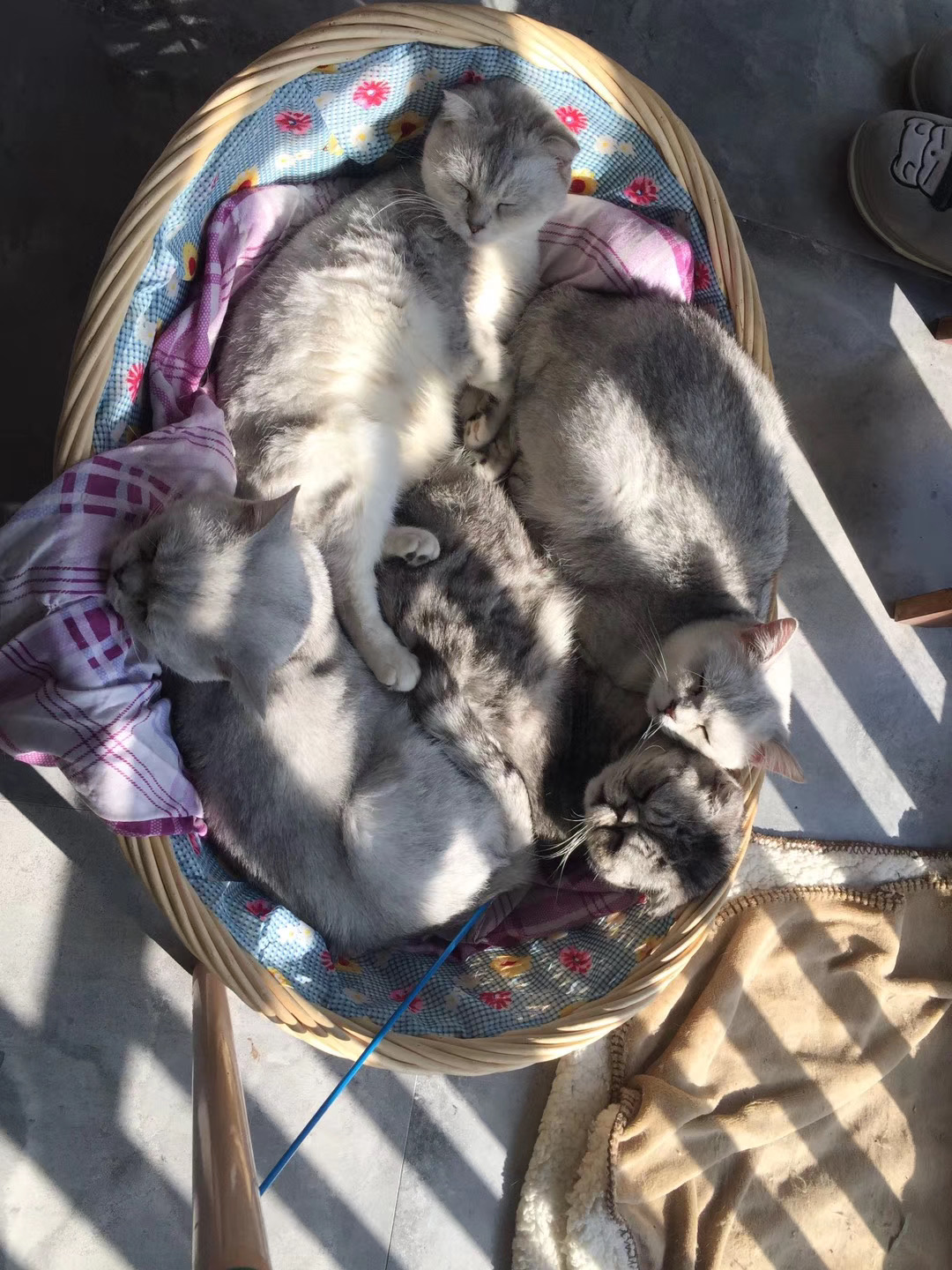
My lovely cats
Since I hadn’t been home for two years, I went out for a drink with friends most nights before my departure. After we arrived at my parents’ home, Wuhan’s epidemic was getting worse. I watched the news and paid more attention to the situation.
I have a friend in Wuhan. So I chatted with him and asked him how it was there. He was shopping at the supermarket and was wearing a mask by then. There were many people in the supermarket. He said that the news of the epidemic was bad. However, people remained very relaxed. Life continued as normal,the epidemic seemed to be no big deal.
My work used for this book’s cover.
At noon on New Year’s Day, our family was still eating out at a restaurant. On the next day, my city suddenly issued an emergency notice that all restaurants, shops, leisure centres, and other public places should close at once – this was mandatory. We lined up outside a shop and started buying masks. The medicine in the pharmacy was almost wiped out. Everyone bought hundreds of RMB worth of medicine to prepare for a long time staying at home. A mask was a few cents, so I bought a pack. The next day we remained at home. The first thing in the morning is to watch the news. We found the number of affected people had increased several times from the previous day. Two days later, all the residential districts were closed. Now you must wear a mask and measure your temperature when entering the residential district. At the beginning of New Year, from the first day to the fifteenth, is a time for families and friends to come together. However, everything had to be cancelled.
Words By Mu Beini at 31/03/2020, translated by Aimin Liu.
From the beginning of the epidemic to the end of January, Wuhan shut down the whole city. For me, life did not change that much as I paint and work mostly from home.
 City of Wu Han, after shut down.
City of Wu Han, after shut down.
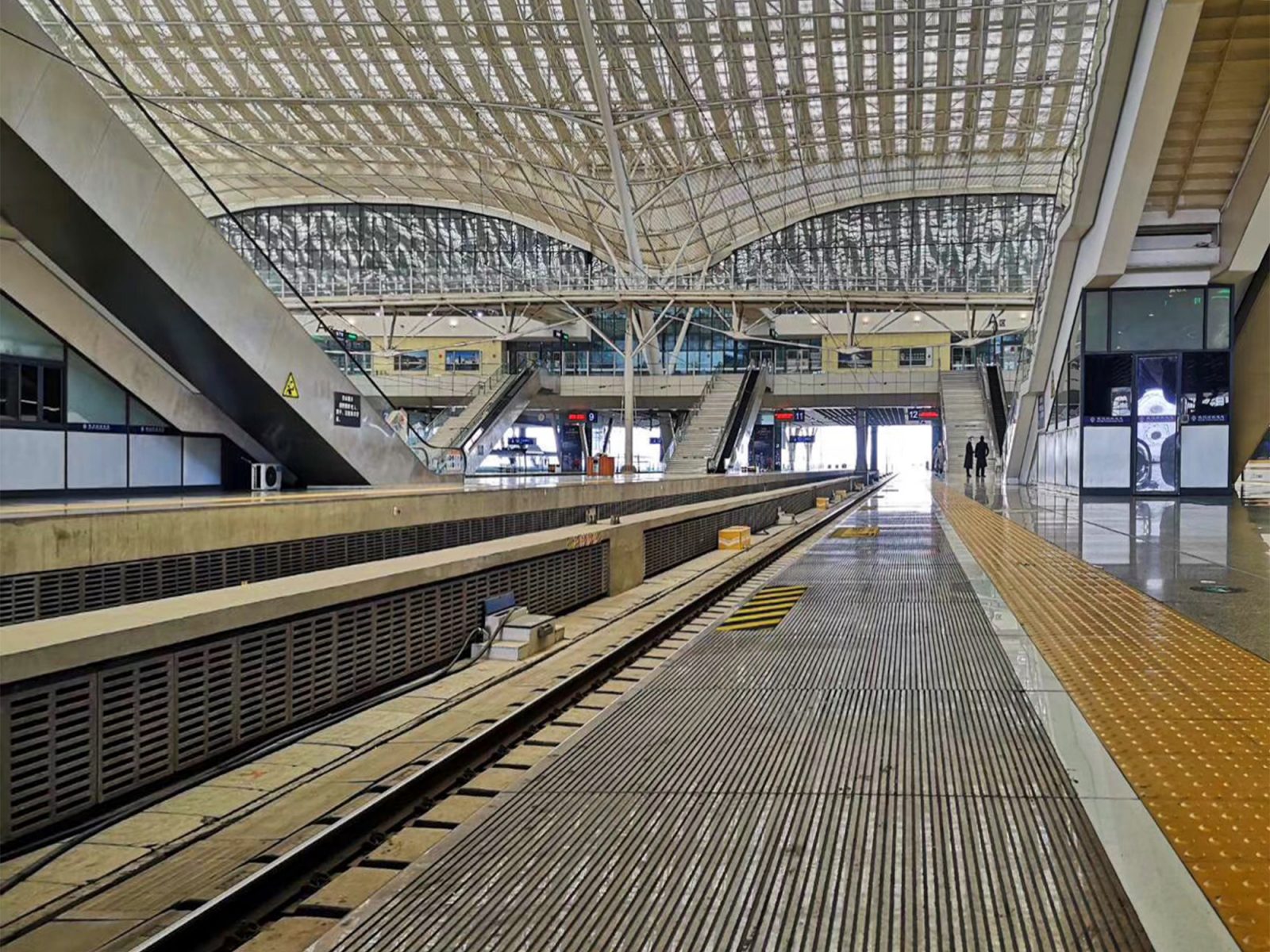 Empty Bullet Train Station
Empty Bullet Train Station
Besides, I had previous experience of disasters, the Tohoku earthquake and the nuclear disaster in Japan in 2011. Following these events, I ended up at home for more than a month. With this previous experience, I felt very calm as we encountered the epidemic. My close friends would joke that I would be the last person to take the epidemic seriously. Also, maybe my character is more pessimistic. I believe in fate and that people’s lives and deaths are already pre-determined. Irrespective of whether you panic or not you will not change your fate. So, I would rather stay calm and work on how to protect my family and try to live fruitfully every single day. Fortunately, the simple pleasures of life in a small family of three makes my life quite satisfying and reassuring.
 Overgrown communal garden in our residential district.
Overgrown communal garden in our residential district.
 Spring is here. When the sun came out, people in the flats took their quilts out on the balcony.
Spring is here. When the sun came out, people in the flats took their quilts out on the balcony.
Since the residential district restrictions on people going out, the management of our building has been very responsible and well organised. Such as – there is a shopping platform for door-to-door delivery, distribution of free food, offers of postal services and haircuts and so on. My thanks go to those who have been working in the front line in property management, to the volunteers and the party members. I’m grateful in my heart for what I’ve seen and for what I’ve experienced. I broke into tears when I watched Chinese medical workers fighting with soldiers on the front line of Corvid-19 on TV. However, as an ordinary citizen, the only thing I could do to help was to stay at home.
 During the epidemic, I draw pictures, read books and check my phone every day.
During the epidemic, I draw pictures, read books and check my phone every day.
 Every day, the family of three stays at home with the cat and waits for the summer, and has been waiting quietly for more than 2 months.
Every day, the family of three stays at home with the cat and waits for the summer, and has been waiting quietly for more than 2 months.
During the epidemic, my students and I drew a set of fight-epidemic postcards for the Hubei Red Cross. These drawings have already been printed and should be published nationwide when the epidemic is over. They are the record I made during the epidemic and I hope they make a small mark in history.
 Wu Han’s train station welcome the first group of people since the epidemic broke out.
Wu Han’s train station welcome the first group of people since the epidemic broke out.
 New work by Mu Beini.
New work by Mu Beini.
All the images’ copyright belongs to the artist Mu Meini.
Chinese New Year will start on 25th January this year, different from most of the countries in the Western world. This is the Year of Mouse in China, as illustrated in the drawing by our young artist Zhu KeCheng below. 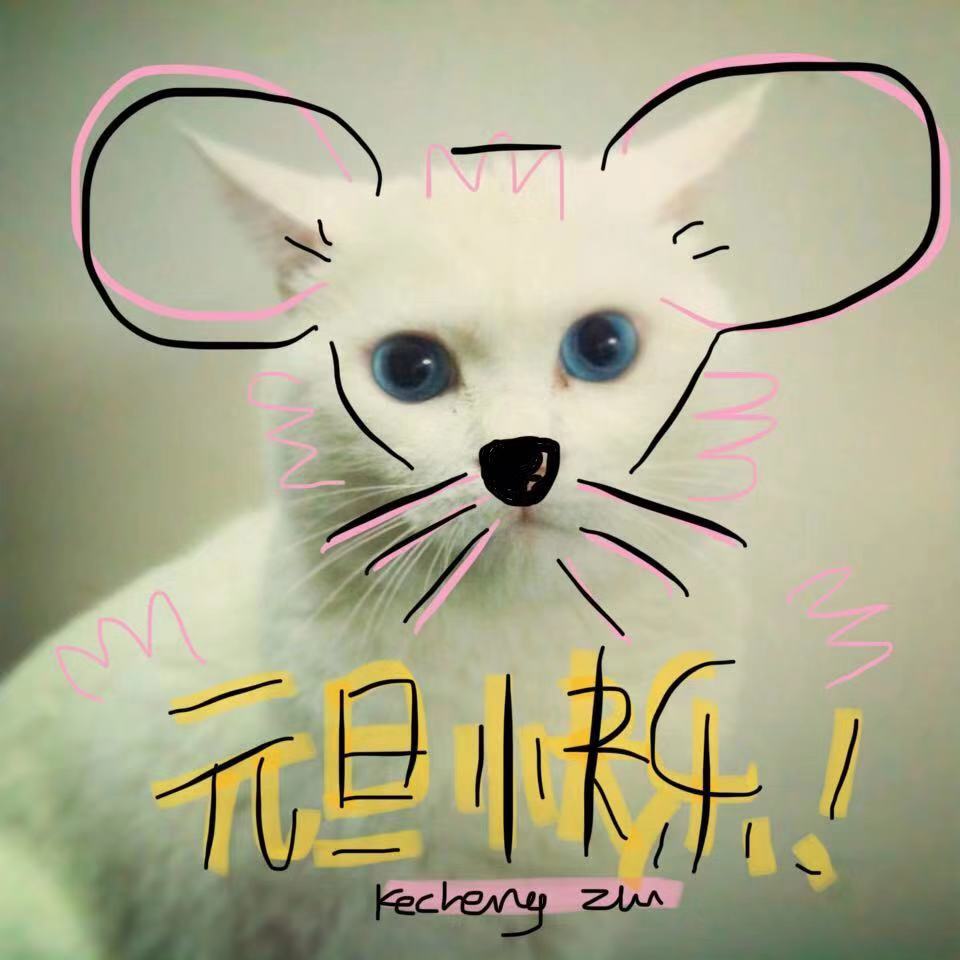
I recently caught up with one of our all time favourite artists, Yu Chengyou, to see how he is doing and what he is planing for the new year. I found out that he is staying in Hainan during the winter season, one of the sunniest islands in southern China, then he will return to his home town, Harbin, which is the coldest province in Northern China. I like his living plan.

 ‘Clear Journey’, 100cm x160cm, water-based woodcut, 2015
‘Clear Journey’, 100cm x160cm, water-based woodcut, 2015
Mr Yu’s solo show ‘Clean Journey’ recently toured to JiangShu Huaian Art Museum. The exhibition started from 31st Dec. and runs through to 15th Jan. The exhibition includes his recent prints, the size of which has increased hugely, even up to 2m. This is evidently to demonstrate his artistic strength and ability in his profession. The car series and farmer’s series give the viewer maximum visual impressions.
 ‘East Red 75’ 120cm x 160cm, water-based woodcut, 2014
‘East Red 75’ 120cm x 160cm, water-based woodcut, 2014
 “Distant . Sunshine” 90cm x 150cm, water-based Woodcut, 2015
“Distant . Sunshine” 90cm x 150cm, water-based Woodcut, 2015
Works like ‘East Red’ Tractor and ‘Combine’ Harvester show the progress and the development in our national technology and modernisation. By applying photo surrealism to represent those big machines’ construction, texture, colour, and the micro-details inside is an extreme challenge with the woodcut technique.
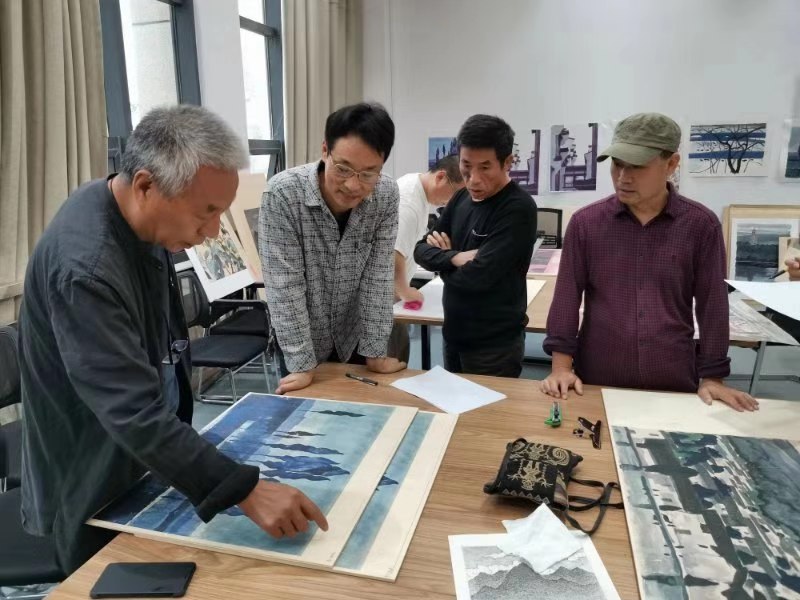
Mr Yu has retired from the institute, often invited back to consult young artists in institutes across the country. As shown in the above photo, Mr Yu was recently in the Hunan Changling Printmaking Institute teaching as a visiting Professor.
Mr Yu also released another good piece of news to me: that he has been appointed as one of only 26 researchers across the country selected to join the printmaking department at the China National Academy of Painting in Beijing.
I admire Mr Yu’s artistic creation and his enduring printmaking practice. I also applaud him for his latest achievement and it is delightful to see his art widely shown nationwide.
Words by Aimin Liu.





 I felt Iprivileged to share the artist’s spiritual journey of their creation.’Church in Assisi’ is the temple of his art. He offers his devotion, his compassion, enduring on his artistic journey. He shared his answer, ‘What is an artist?’ with the world.
I felt Iprivileged to share the artist’s spiritual journey of their creation.’Church in Assisi’ is the temple of his art. He offers his devotion, his compassion, enduring on his artistic journey. He shared his answer, ‘What is an artist?’ with the world.






























 ‘Blossoming Apricot Tree II’, Acrylic on Canvas, 105cm x 690cm, 2020
‘Blossoming Apricot Tree II’, Acrylic on Canvas, 105cm x 690cm, 2020 ‘Blossoming Apricot Tree III’, Acrylic on Canvas, 200cm x 750cm, 2020
‘Blossoming Apricot Tree III’, Acrylic on Canvas, 200cm x 750cm, 2020 ‘Blossoming Apricot Tree IV’, Acrylic on Canvas, 320cm x 240cm, 2020
‘Blossoming Apricot Tree IV’, Acrylic on Canvas, 320cm x 240cm, 2020

 The little things in our daily life that we take for granted can often be a major endeavour for them. I can still remember all the start points of my own uncle who able to do first time in his life, such as to be able to sit up eating, to walk without walking sticks, to get on a train, go to the cinema, climb the mountain…
The little things in our daily life that we take for granted can often be a major endeavour for them. I can still remember all the start points of my own uncle who able to do first time in his life, such as to be able to sit up eating, to walk without walking sticks, to get on a train, go to the cinema, climb the mountain…
























 Zhu Jianhui at his studio in Qi Dong, Shanghai.
Zhu Jianhui at his studio in Qi Dong, Shanghai. Sometimes it is necessary to hold the wound flat, Poster.
Sometimes it is necessary to hold the wound flat, Poster. My Eyes, water colours
My Eyes, water colours 2020, water-based woodcut, 70cm x110cm
2020, water-based woodcut, 70cm x110cm Magic Cube II, Water-based woodcut.
Magic Cube II, Water-based woodcut. Magic Cube IX, Water-based woodcut.
Magic Cube IX, Water-based woodcut. Magic Cube XIV, Water-based woodcut.
Magic Cube XIV, Water-based woodcut. Cube II, Chinese Ink Painting
Cube II, Chinese Ink Painting Cube X, Chinese Ink Painting
Cube X, Chinese Ink Painting Cube IX, Chinese Ink Painting
Cube IX, Chinese Ink Painting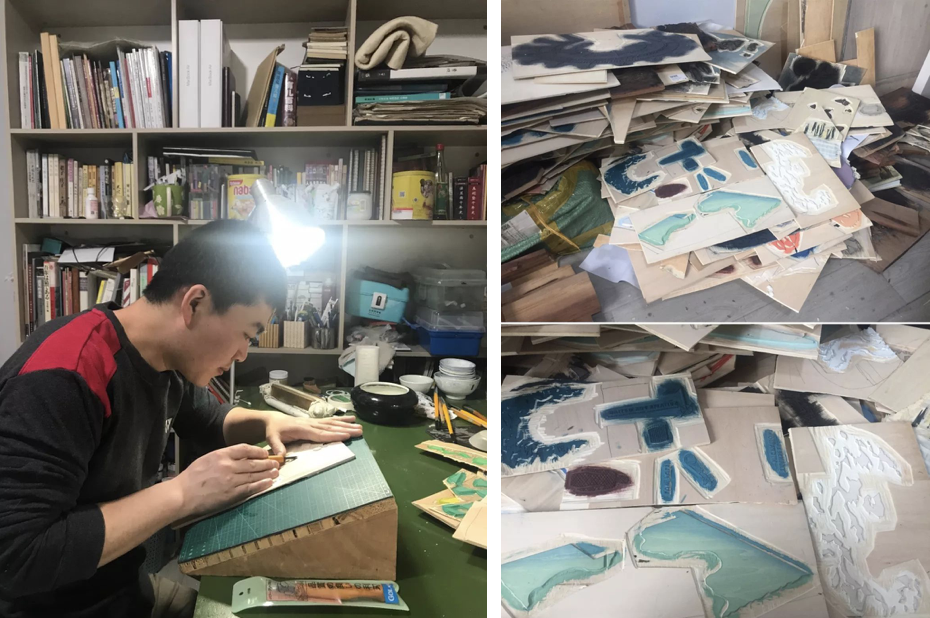
 My lovely cats
My lovely cats
 City of Wu Han, after shut down.
City of Wu Han, after shut down. Empty Bullet Train Station
Empty Bullet Train Station Overgrown communal garden in our residential district.
Overgrown communal garden in our residential district. Spring is here. When the sun came out, people in the flats took their quilts out on the balcony.
Spring is here. When the sun came out, people in the flats took their quilts out on the balcony. During the epidemic, I draw pictures, read books and check my phone every day.
During the epidemic, I draw pictures, read books and check my phone every day. Every day, the family of three stays at home with the cat and waits for the summer, and has been waiting quietly for more than 2 months.
Every day, the family of three stays at home with the cat and waits for the summer, and has been waiting quietly for more than 2 months. Wu Han’s train station welcome the first group of people since the epidemic broke out.
Wu Han’s train station welcome the first group of people since the epidemic broke out. New work by Mu Beini.
New work by Mu Beini.

 ‘Clear Journey’, 100cm x160cm, water-based woodcut, 2015
‘Clear Journey’, 100cm x160cm, water-based woodcut, 2015 ‘East Red 75’ 120cm x 160cm, water-based woodcut, 2014
‘East Red 75’ 120cm x 160cm, water-based woodcut, 2014 “Distant . Sunshine” 90cm x 150cm, water-based Woodcut, 2015
“Distant . Sunshine” 90cm x 150cm, water-based Woodcut, 2015